

Hidden London tours: The secrets of Down Street Tube station
Posted on Last updated: April 8, 2020
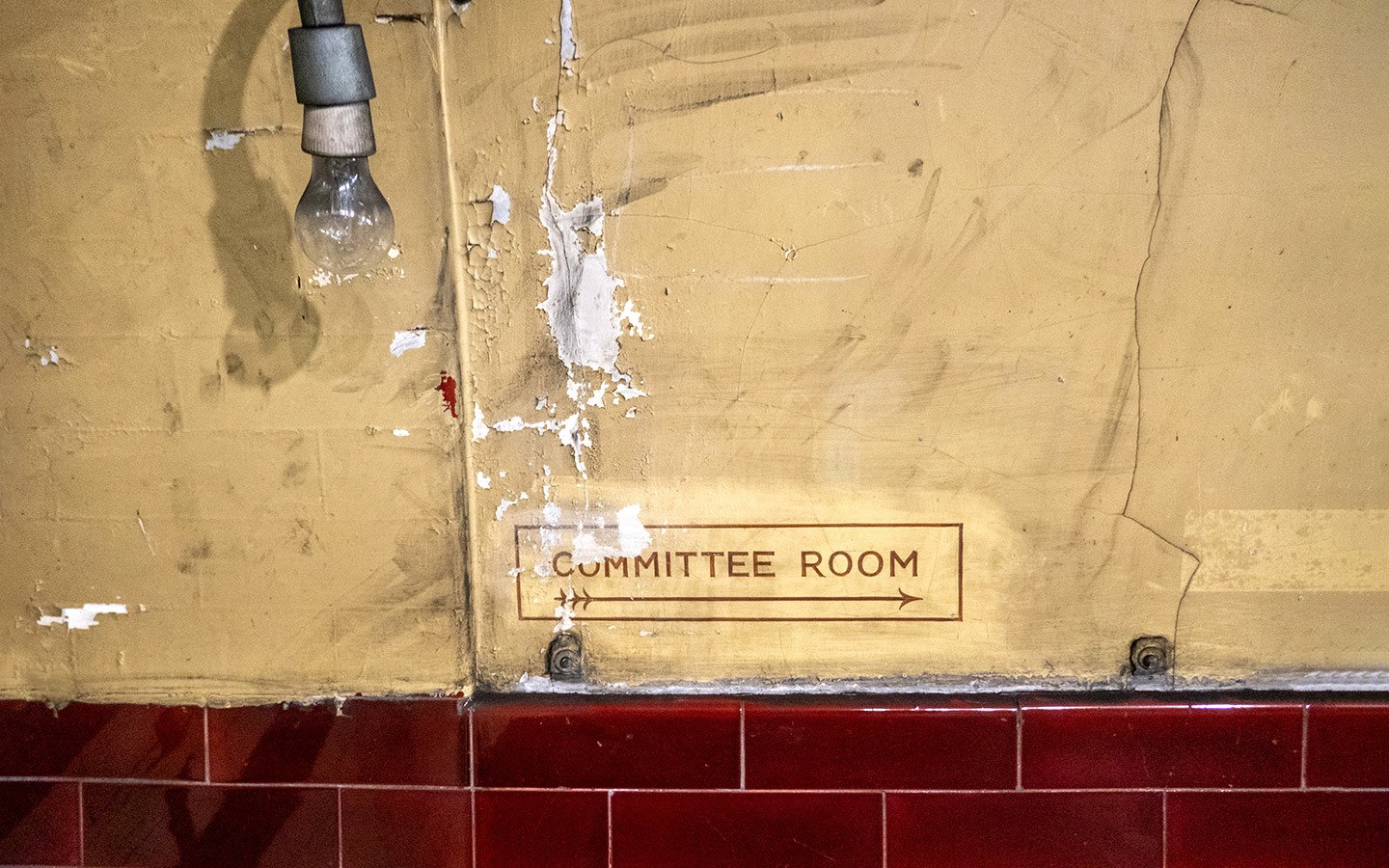
Beneath the streets of London is a hidden underground world of abandoned Tube stations and deserted tunnels, each with their own story to tell. Most of them are locked away and inaccessible, but a series of Hidden London tours run by the London Transport Museum gives you access to this secret underground world. Their mix of history, architecture and the chance to get beyond the barriers makes them one of my favourite alternative things to do in London – so I headed underground for the third time to Mayfair’s Down Street, a station whose wartime history and connection to Winston Churchill make it one of the most fascinating.
My visit was hosted by the London Transport Museum, but all views are my own.
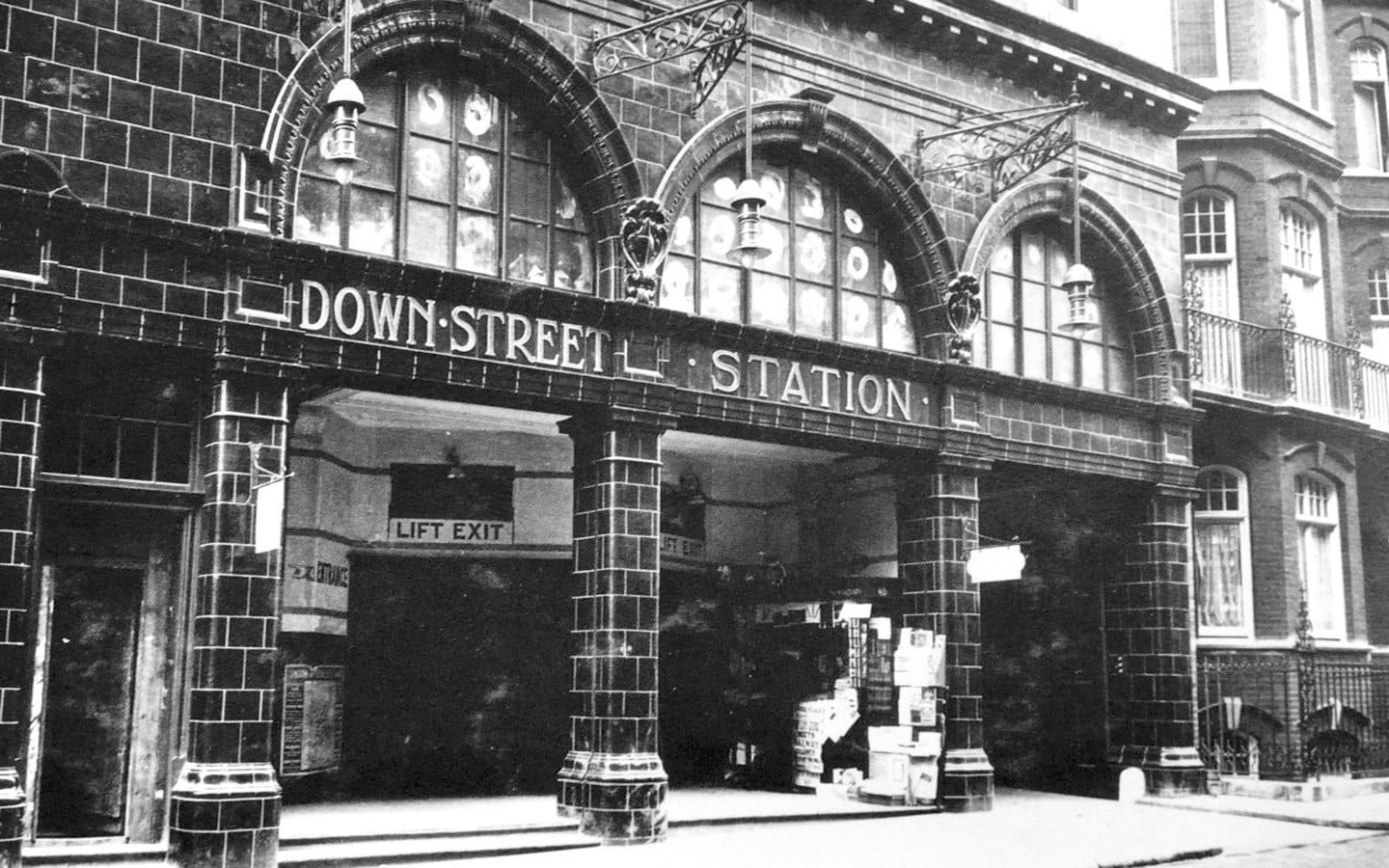
Down Street in its Tube station days – photo credit London Transport Museum
The history of Down Street Tube station
Down Street opened in March 1907 as part of the new Great Northern, Piccadilly and Brompton Railway (now on the Piccadilly line). Land disputes and layout issues meant it opened late, and it never really caught up. It was too close to other stations and trains didn’t always stop. And being hidden away down a side road off Piccadilly didn’t help – surrounded by rich local residents who had their own transport and didn’t want Tube signs spoiling the neighbourhood.
With nearby Green Park and Hyde Park Corner stations being enlarged for escalators to be built and the Piccadilly line extension in 1929 putting the pressure on to close quieter stations, Down Street’s time was up. It finally closed in May 1932, destined to spend the rest of its days as a ventilation shaft for the Piccadilly Line. Well at least until the Second World War broke out, when it got a new life as the secret headquarters of the Rail Executive Committee (REC).
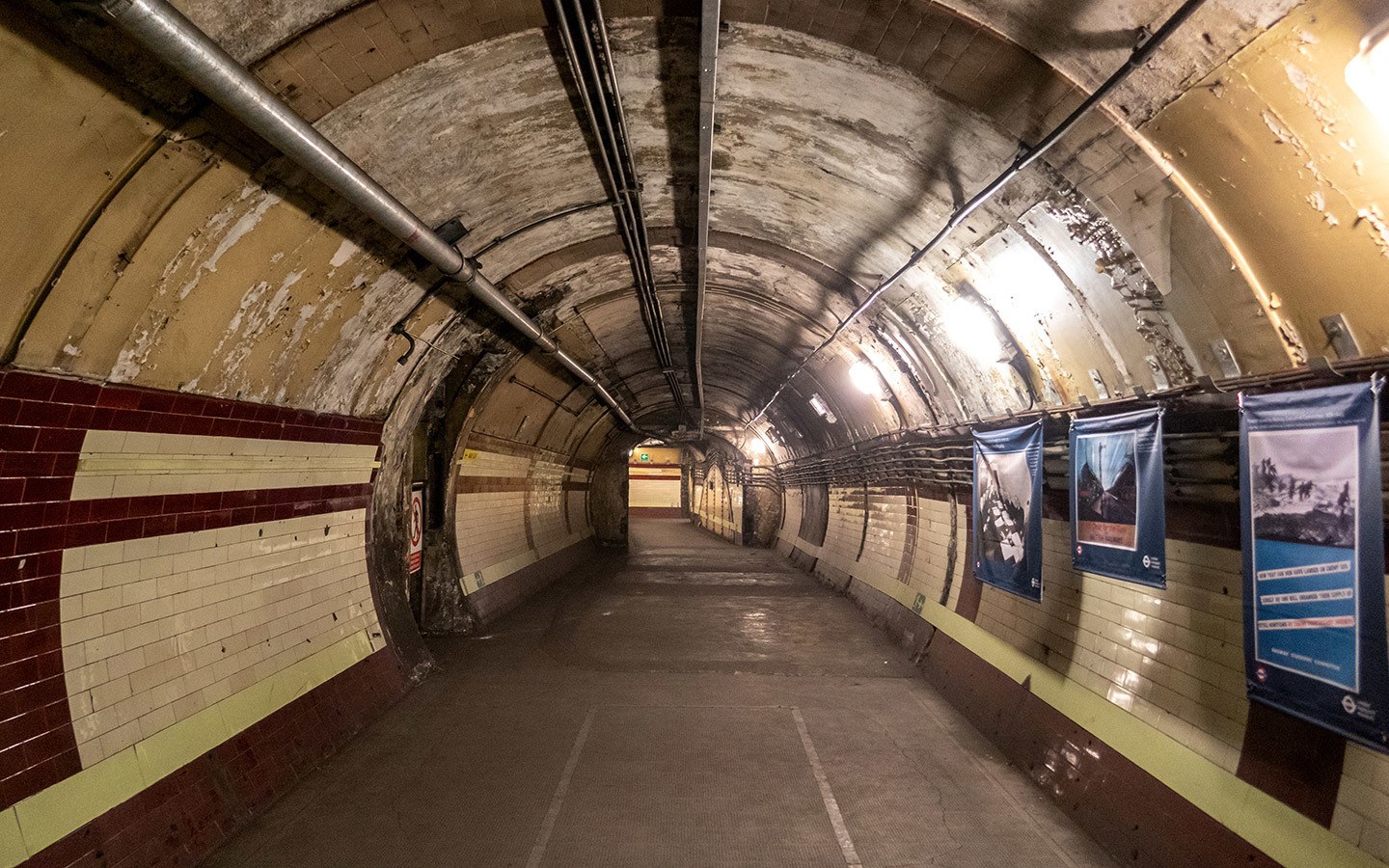
Inside Down Street – with the meeting room table marked out on the floor
The REC controlled Britain’s railways during the war – making sure people, weapons and supplies were where they needed to be. Made up of representatives of the four mainline railway companies plus the London’s transport board, they needed a wartime HQ that was bombproof, had a central London location and was big enough to house an underground telephone exchange. Enter Down Street, whose deep tunnels and Mayfair location made it perfect.
So in 1939 the tunnels got a makeover – converted into a network of offices and meeting rooms, with living accommodation for up to 40 staff. Bombproof, gas-proof and hidden away from prying eyes, it was seen as the safest place during the Blitz so was used by Winston Churchill as a shelter until the Cabinet War Rooms were ready (the off-ration supplies of caviar, Champagne and cigars might have helped). Once the war was over the tunnels were cleared and abandoned. So what’s left of Down Street now? I took a trip back in time to find out its secrets.
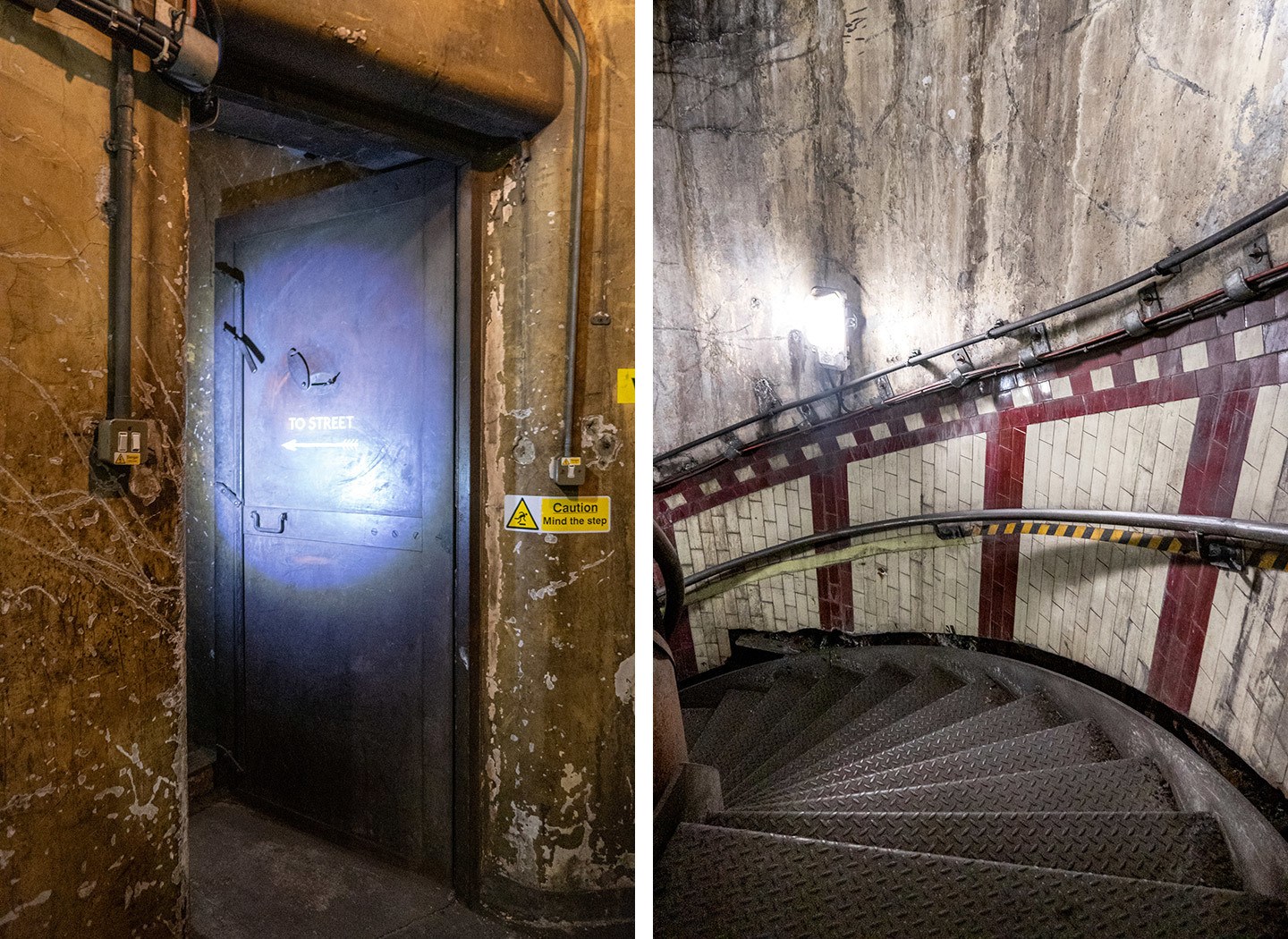
Heading underground
Hidden London’s Down Street Tube station tour
Our Down Street Tube tour started in an office building tucked down a side street in Mayfair, where we were kitted out with torches and given a safety briefing before heading to the station entrance. What was the ticket office is now the Mayfair mini-market, but if you look up it still has that distinctive Tube station look, with its arches and oxblood red tiles marking it out as one of the 50 stations designed by Leslie Green in his distinctive Arts and Crafts style.
A thick metal door takes you inside, where you can see traces of the different phases in its history all around you. There’s the original tiling from its days as a Tube station, the wartime signs and peeling yellow painted walls which were used to mark the public spaces, and the modern notices in case it’s needed as an emergency exit from the Piccadilly Line.
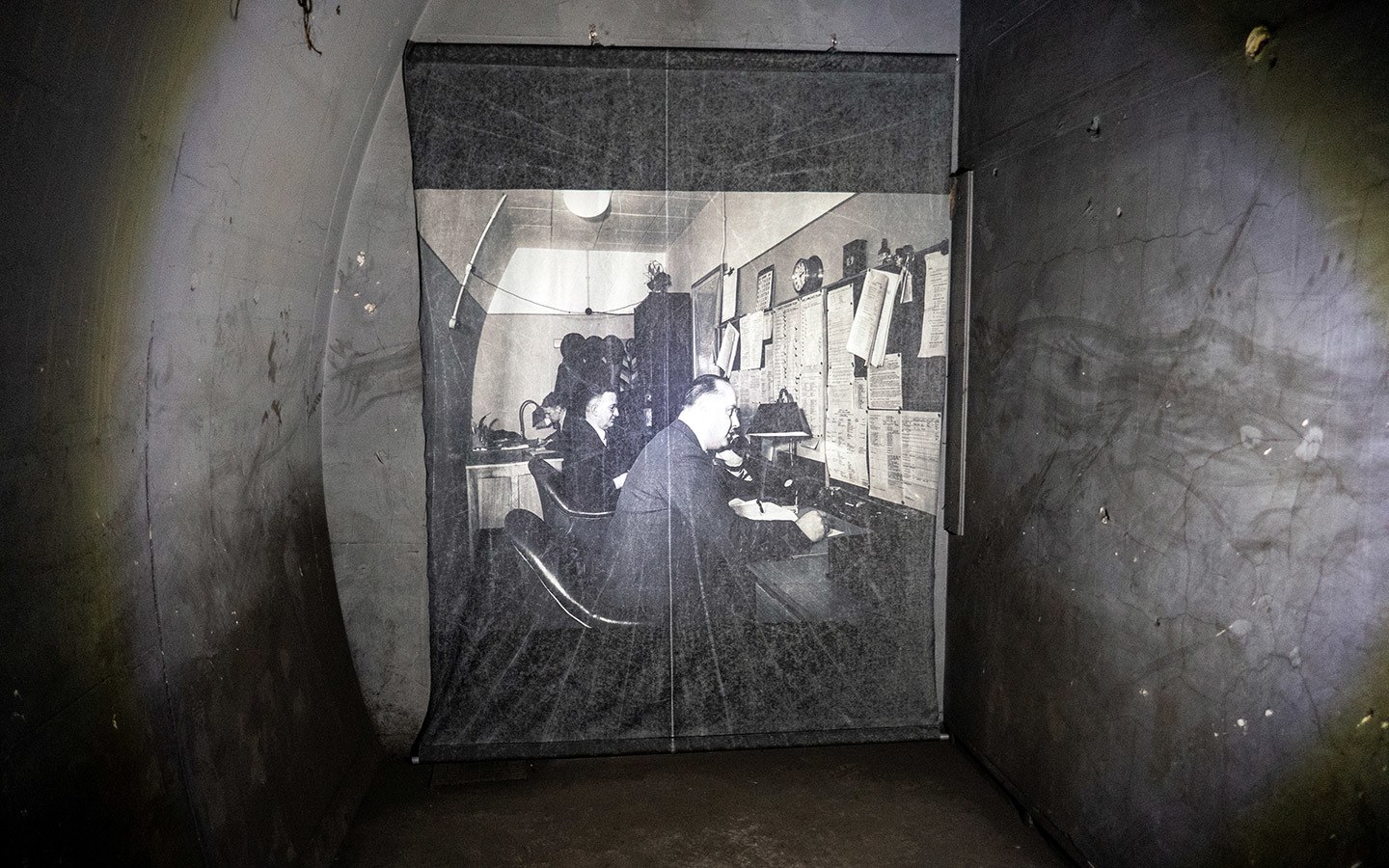
Working underground
The lifts built for the REC have long since been removed, so we headed down 122 spiral stairs to reach the main tunnel. Almost everything was stripped out at the end of the war, turning the tunnels back into ventilation shafts, but photos and documentary records have been used to piece together how the space was used. And as we walked through the different sections, squeezing our way through tight spaces into different rooms, there were echos of what it must have been like living and working underground while London battled the Blitz.
Ghosts of its past life still remain – snipped off wires hanging from ceilings, shadows where clocks hung on the walls, marks where gas-proof doors once stood, an old tin bath in a tiny partitioned bathroom, fat-stained kitchen walls where chefs would cook up off-ration steak, the button REC executives would press to summon more Champagne in the dining room. And the one thing still there in its entirety is the telephone exchange – clearly getting that back out was a bit too much of a challenge, so it sits in a corner, layered with 70 years of grime.
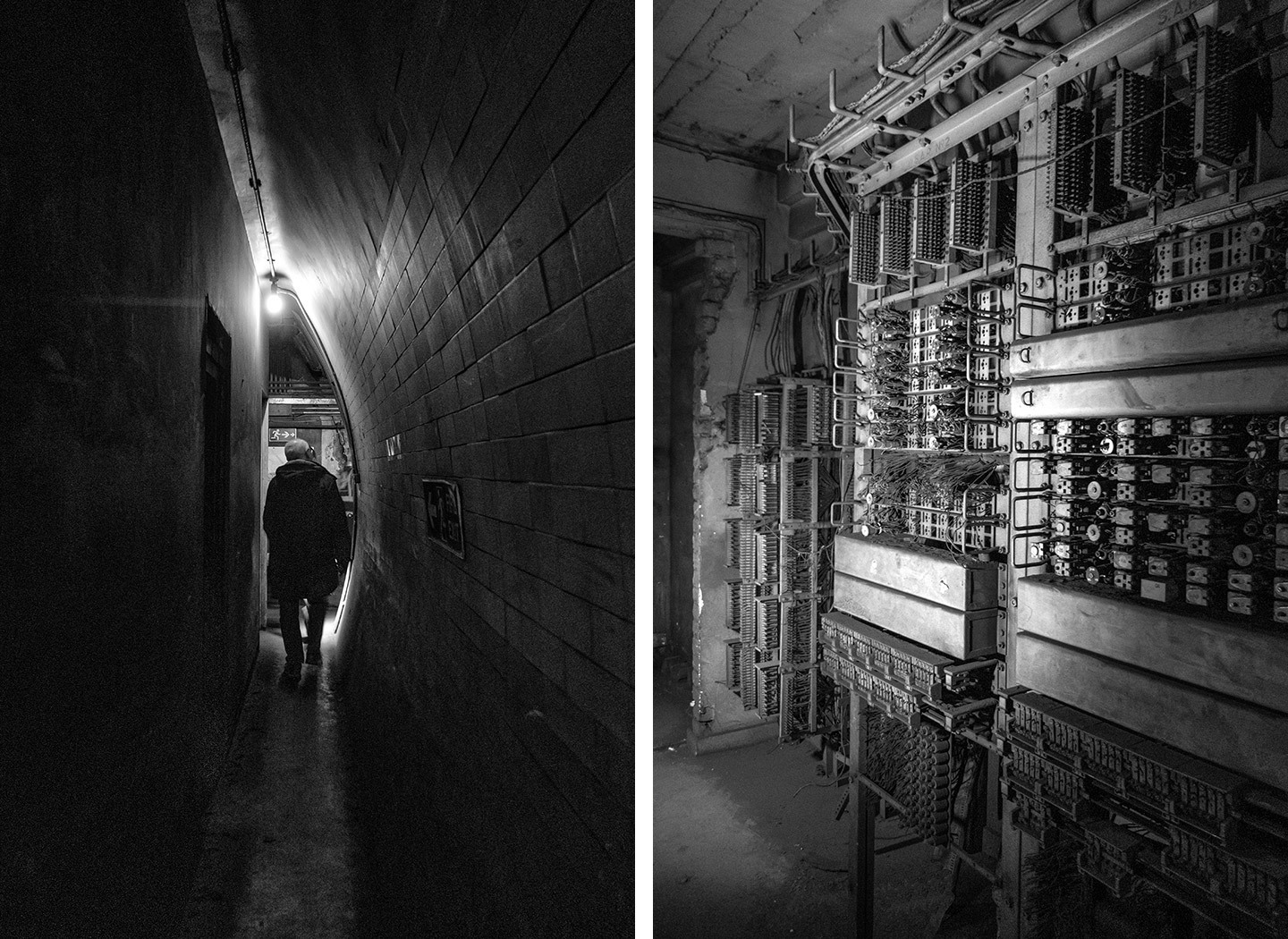
Narrow corridors and the old telephone exchange
Every tiny bit of space was made use of. When the station was converted in 1939, the tunnels were kitted out by railway carriage fitters – guided by REC secretary Gerald Cole Deacon, whose sailing experience came in handy when it came to getting the most out of the space. As well as meeting rooms, offices, a typing pool and telephone exchange, dormitories, bathroom, kitchens and dining rooms made it into a self-contained underground settlement.
No one knew that Down Street was there, so staff would work and sleep in shifts so they didn’t draw attention to the site by coming and going. And being down there it’s amazing to think that up to 40 people lived and worked in these tunnels at a time, packed into such tiny spaces – connected by corridors just wide enough to get a tea trolley down. It was cramped, dark, stuffy and most of all noisy, with trains running day and night. And they still run right past.
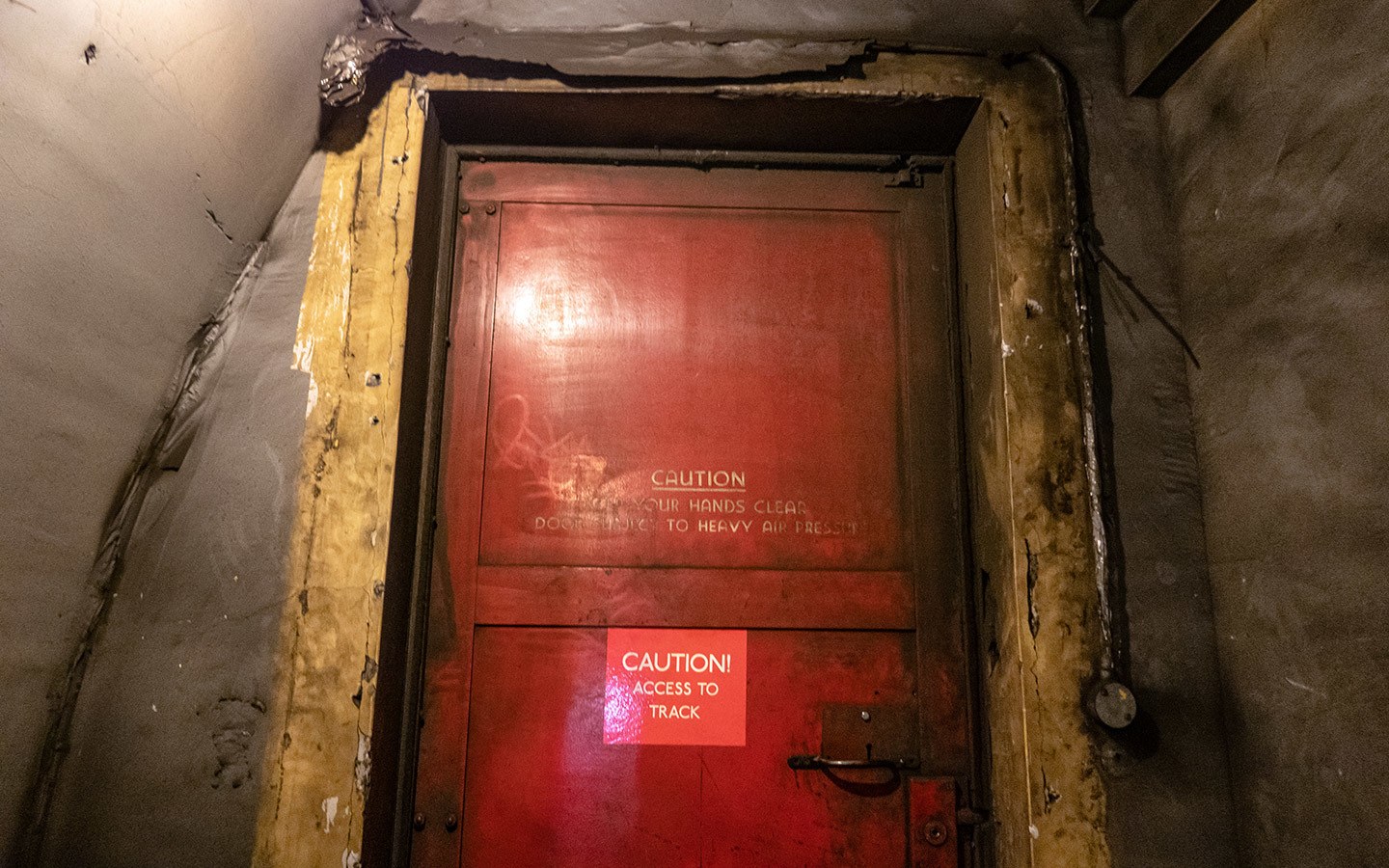
Doorway to the tracks
Every time a train passed we were told to turn out our torches so we didn’t startle the drivers, and standing in the dark with trains rumbling past and dust and air swirling around gives you an insight into how disorientating it must have been to spend weeks at a time down there.
The trains pass just a few feet away, and when one slowed down we could see into the carriage at passengers who had no idea that we or any of the tunnels were down there. A section of the platform was left open so REC executives could signal to to picked up by passing trains – which made me wonder about those unexpected mid-tunnel stops on the Tube these days?
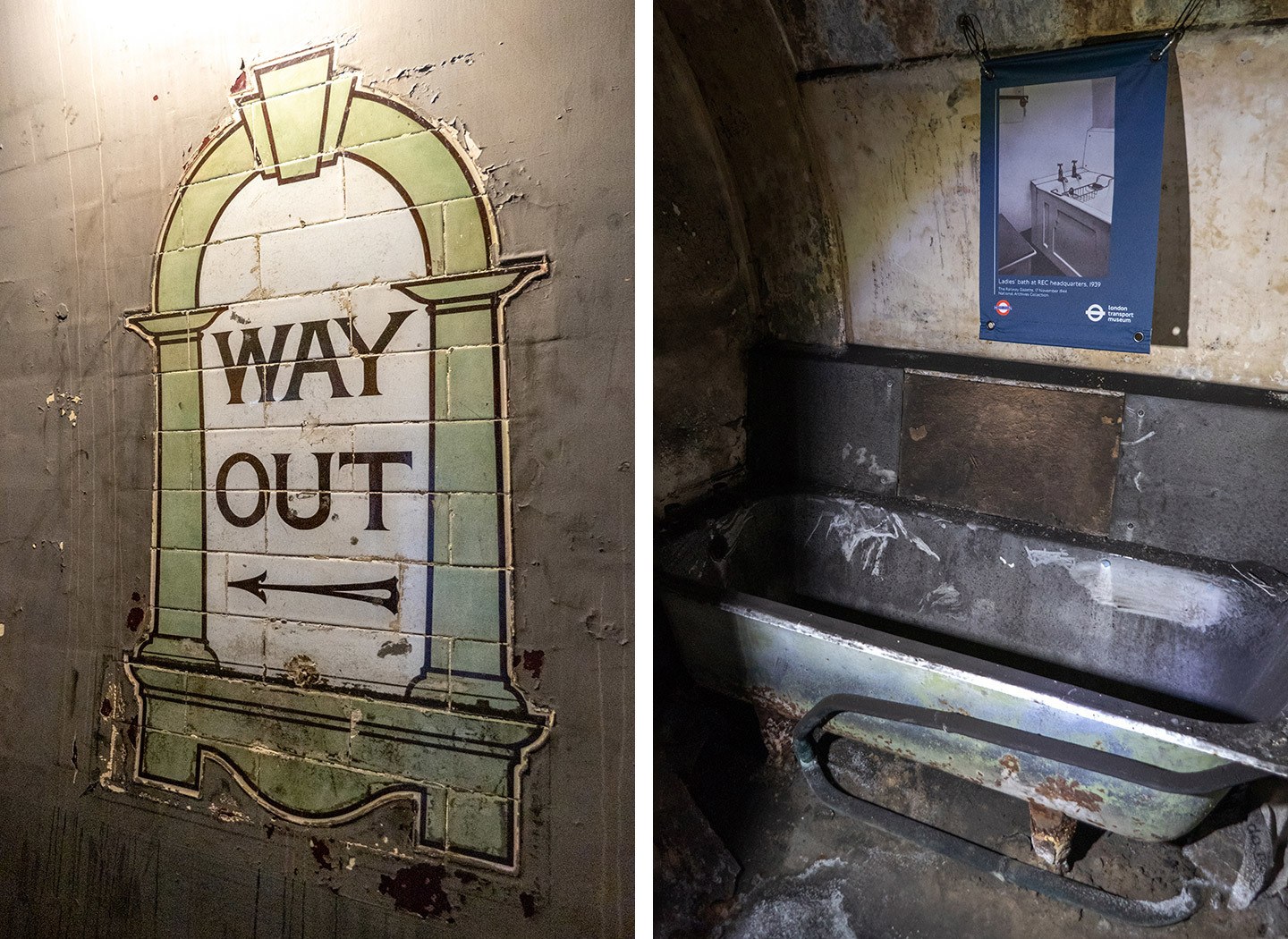
Original tiling and the old bathrooms
Although every bit of space from the two main tunnels was made use of, when Down Street was converted there were strict instructions that the emergency tunnel was to be kept clear for ventilation. But in 1941, an order from above came that ‘a certain gentleman’ had requested his own personal quarters be constructed down there, and within six weeks they were ready.
It’s thought that Churchill never actually made use of his Down Street quarters, but with the discovery of more historic records and documents, there might well still be more stories to uncover and more secrets of Down Street Tube station still hidden away underground.
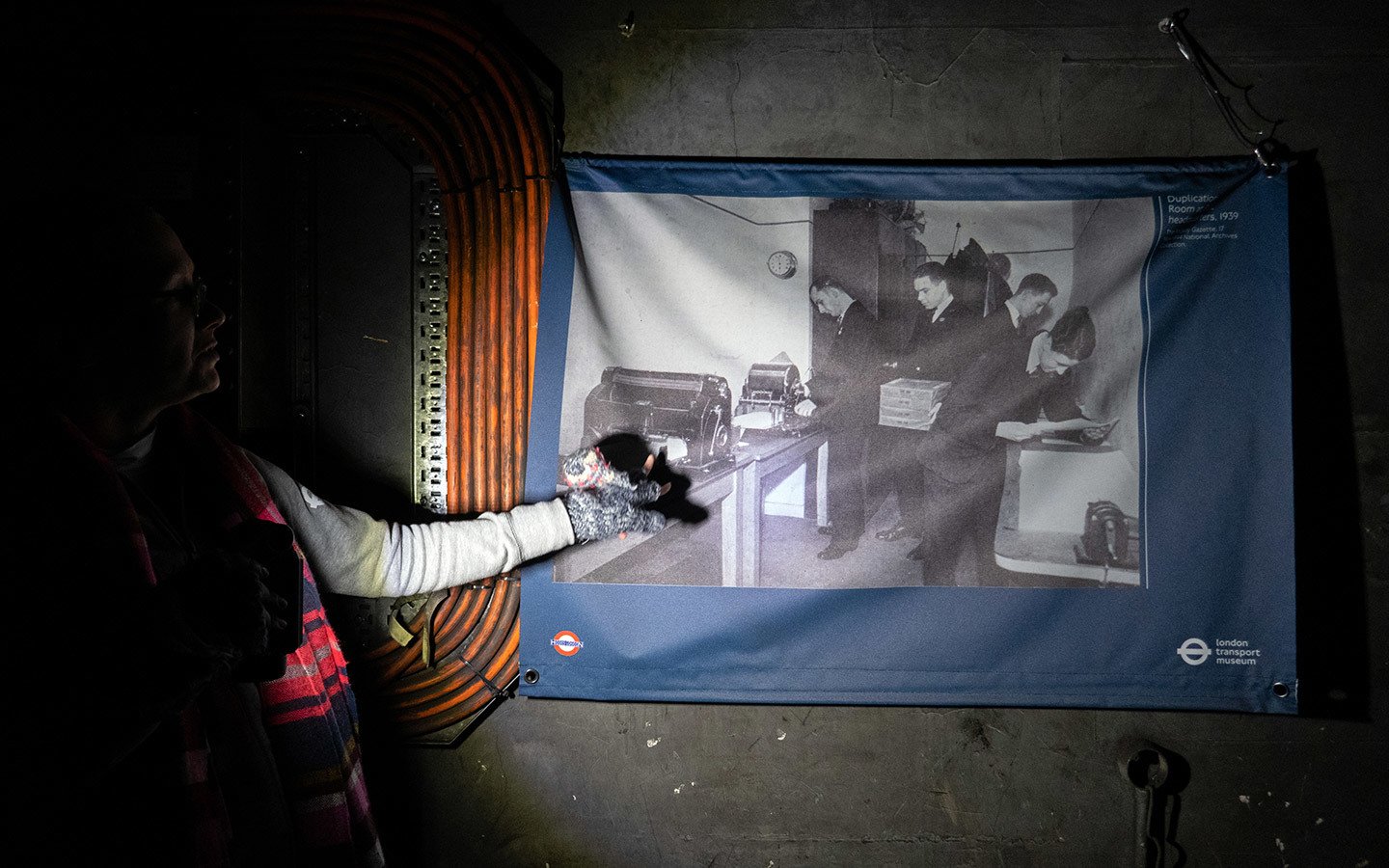
Our guide lighting the way
The details
Down Street is one of the London Transport Museum’s Hidden London tours, which cover eight different underground sites across the city. The Down Street tour takes 90 minutes and costs £85 per person (£80 concessions), including include a one-day pass to London Transport Museum. Hidden London tickets go on sale a few times a year and usually sell out fast, so it’s worth signing up to the mailing list to get notified when the next batch will be released.
Please note that visitors need to climb up and down 122 stairs on the tour – there’s no lift or toilets on the route and it can be dark and includes small spaces and uneven pathways. You can also take a special tour and cocktails package (£104 per person or £99 concessions) which includes a gin or whisky cocktail at nearby Flemings Hotel in Mayfair as well as a sharing food platter – not quite Churchill’s Champagne and caviar but a very good end to the tour!

Cocktails at Flemings
Read more London posts
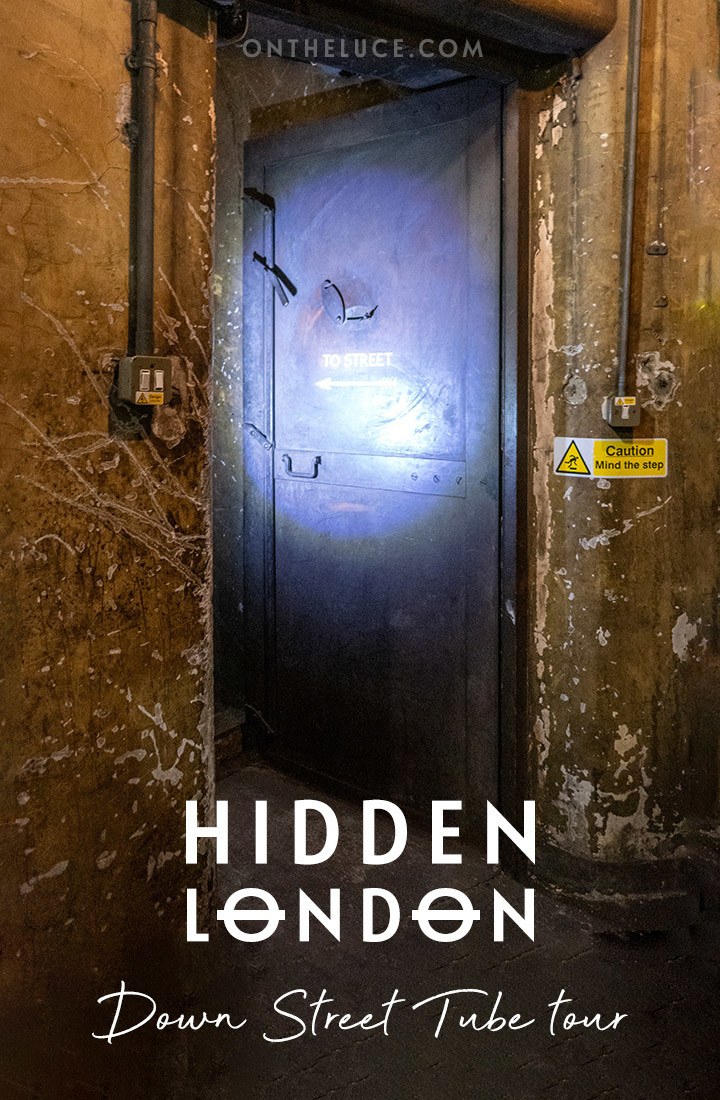
Veronica Franks
Thursday 12th of May 2022
Could you tell me if I can go on a tour of Down Street station please?
Lucy Dodsworth
Friday 13th of May 2022
Hi, yes tours are available to book through Hidden London at the London Transport Museum – these are the current dates https://www.ltmuseum.co.uk/whats-on/hidden-london/down-street
Colin Affleck
Tuesday 11th of August 2020
Many thanks for this. I'll get right on it. Cheers! Colin
Sunday 2nd of August 2020
Hello Some time ago I finished the biography of my late mother Beryl M. Affleck (nee Dodd) 1923-2007. While not explicitly naming Down Street station in my conversations with her, I am quite certain that she was employed there during the blitz as a telephone operator or 'telop'. Do you have any idea how I might confirm that this was so? Are there any lists or government files that might be able to help? Many thanks in advance. Colin Affleck
How interesting! It must have been a fascinating place to work. The site is managed through the London Transport Museum so they should be able to put you in touch with whoever is the best person to speak to about accessing records. Best of luck with your search.
Emily-Ann Elliott
Tuesday 28th of January 2020
This sounds brilliant! It's amazing to think of how much is hidden below us when we're rushing around in London!
Yes there's a whole secret underground world we don't know about!
Monday 27th of January 2020
Sounds fascinating I might give this a go when I’m next in London
Definitely worth a trip!
- Skip to main content
- Skip to primary sidebar
About London Laura - London and Beyond
in London · 7 01 2022
Down Street Hidden London Tour
Can I tempt you to 90 minutes in a damp, disused underground station where you may have to wait in darkness? Go on, it’s well worth it.
Down Street London underground station opened on 15 March 1907. It was on the new Great Northern, Piccadilly & Brompton Railway (GNP&BR) which we now call the Piccadilly line.
Its importance is not as a tube station though but as safe office headquarters during World War Two and as a secret refuge for a very famous leader.

Street Level
As the station wasn’t permitted on the main road (Piccadilly) it was located down a side road, with long underground tunnels to connect to the line running under Piccadilly itself.
The surface station was designed by Leslie Green who was commissioned to design 50 London Underground stations in the early 1900s. His distinctive style is easily recognisable with a classical Arts and Crafts style and ox-blood glazed tiled façade. He used a steel frame roof to support buildings on top, meaning railways could charge rent.
Inside the Leslie Green stations, different tile colour schemes helped illiterate passengers identify each station. Here, there are maroon and cream tiles.
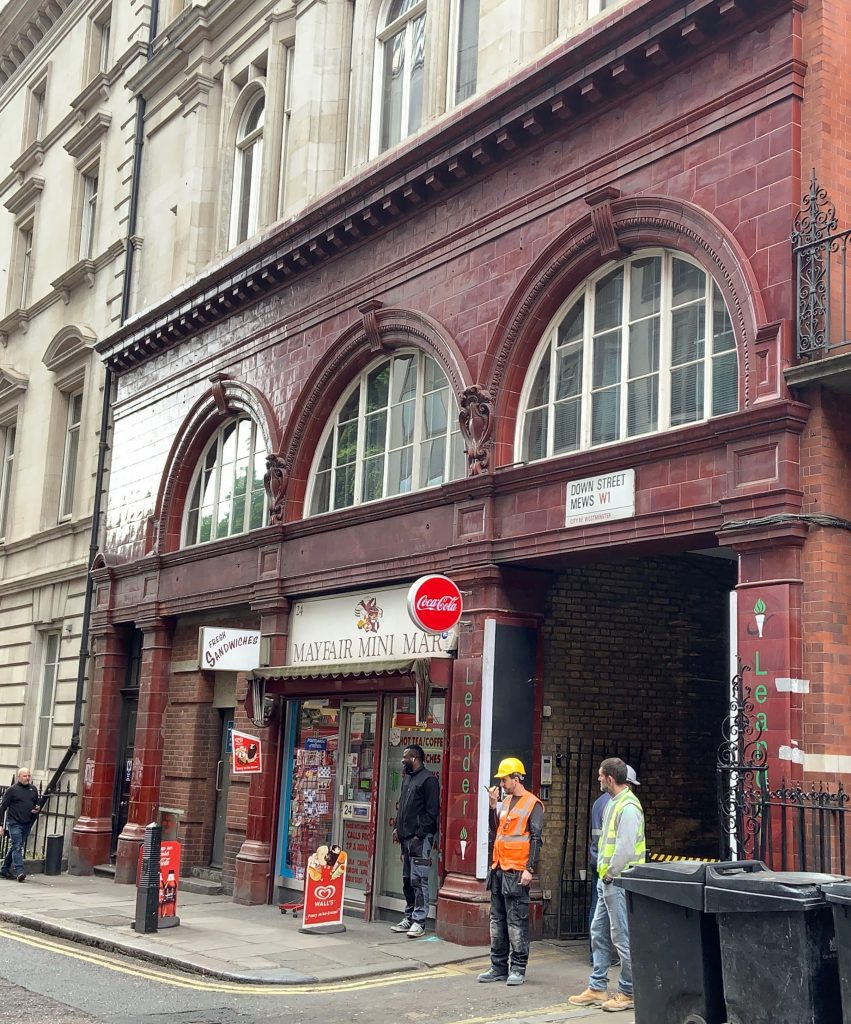
The entrance was where the newsagent is today. When the station opened in 1907, there were protests as there were concerns a station in upper class Mayfair may bring the riff-raff to the area. Local residents had ensured there was no signage on Piccadilly, and they didn’t need the station either as they largely had their own transport.
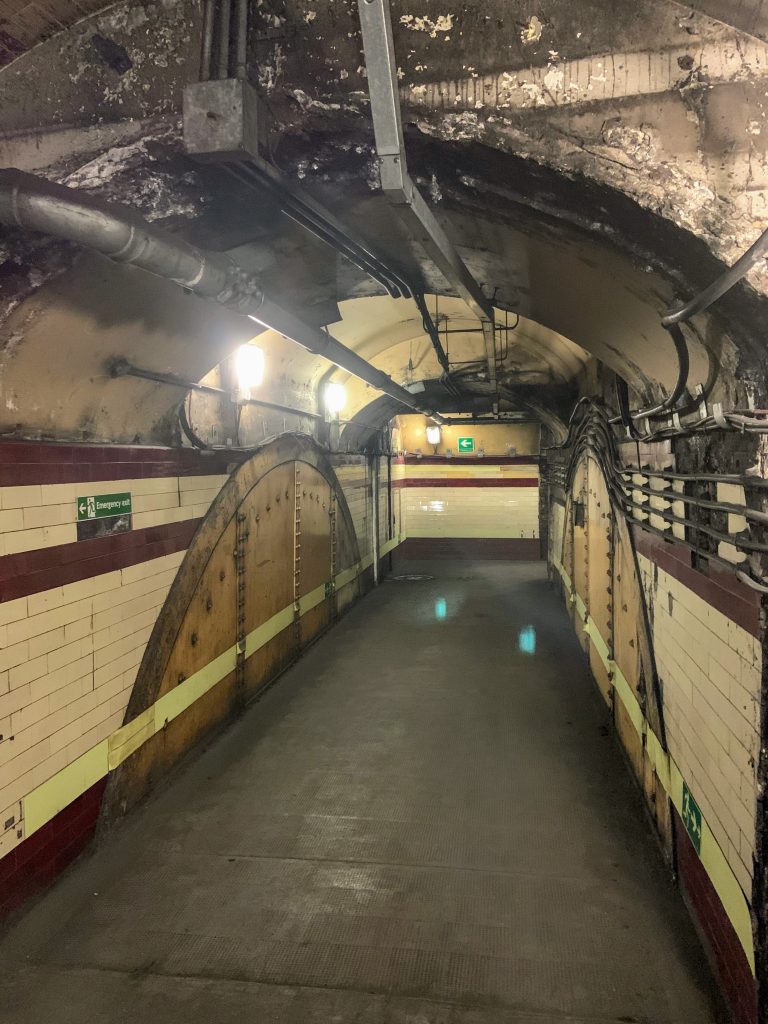
By 1909 there was a reduced service, and from 1918 there was no Sunday service. Down Street only lasted for 25 years and closed on 21 May 1932. The lift shaft was removed in 1932 as it could be used in another station.
It was never a busy station with the long walk from the station entrance to the platforms, plus Hyde Park Corner and Green Park were nearby and had escalators.
Once closed, the passageways were then used as a ventilation shaft for the Piccadilly line.
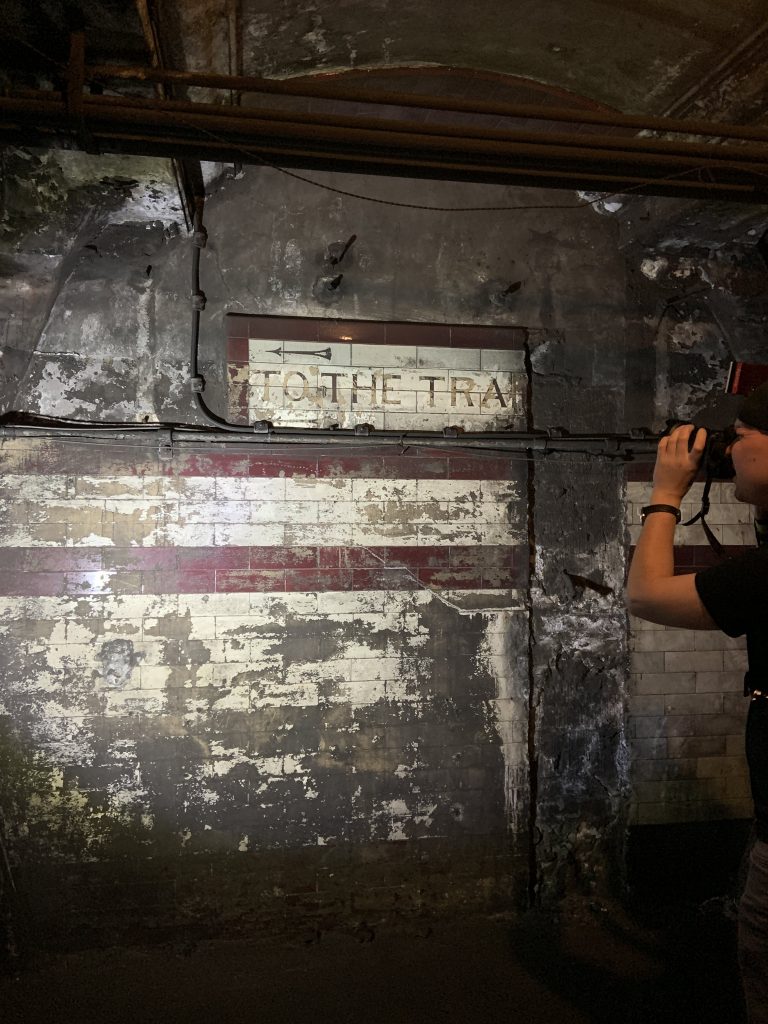
Preparations to defend the nation before the outbreak of war meant the Railway Executive Committee (REC) was formed in September 1938. The REC was tasked with keeping all trains running throughout World War Two across England, Scotland and Wales (including London Underground). This was not just passenger trains but also munition trains and milk trains too.
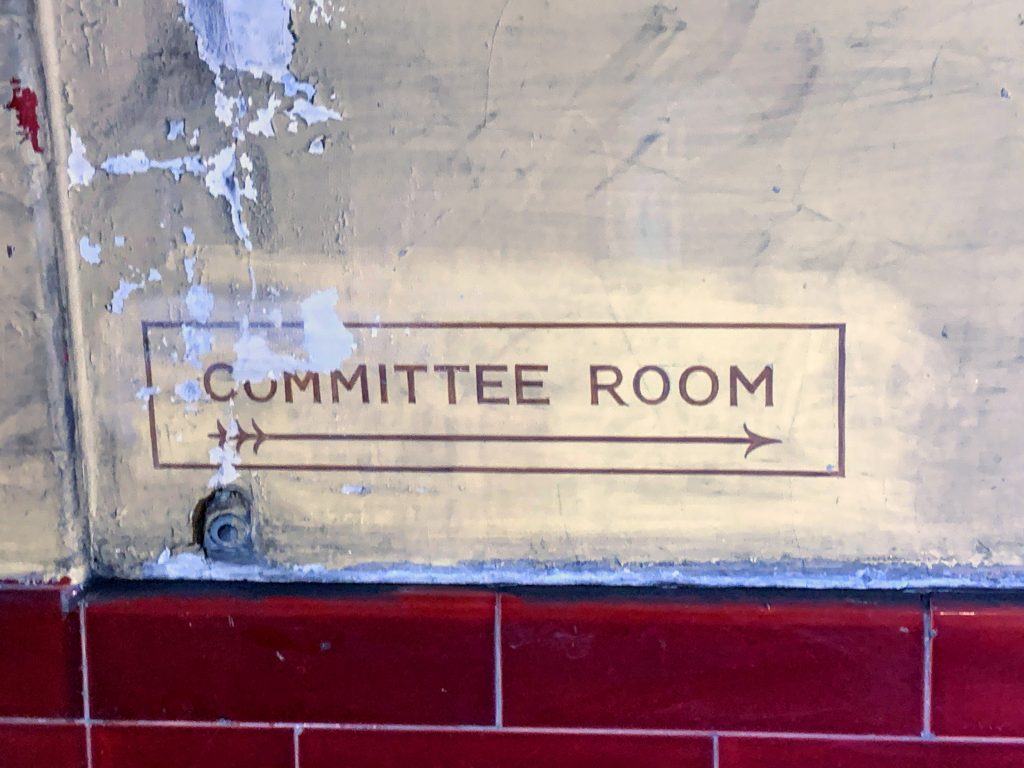
With fears that their current Westminster HQ, a sizeable building close to the Houses of Parliament, wouldn’t survive an aerial attack, it was Gerald J Cole Deacon, REC Secretary, that remembered the abandoned tunnels of Down Street. By the start of March 1939, the government confirmed the REC was an essential service and by the end of the month, the REC had signed a lease from London Transport (LT) for Down Street station to be their bomb-proof wartime headquarters. Plans were approved by April 1939 and construction began on converting the space. The enclosed platform areas and space in the passages were divided up into offices, meeting rooms, toilets and dormitories. It even had a telephone exchange. Canary yellow paint was used to make the area seem less industrial.
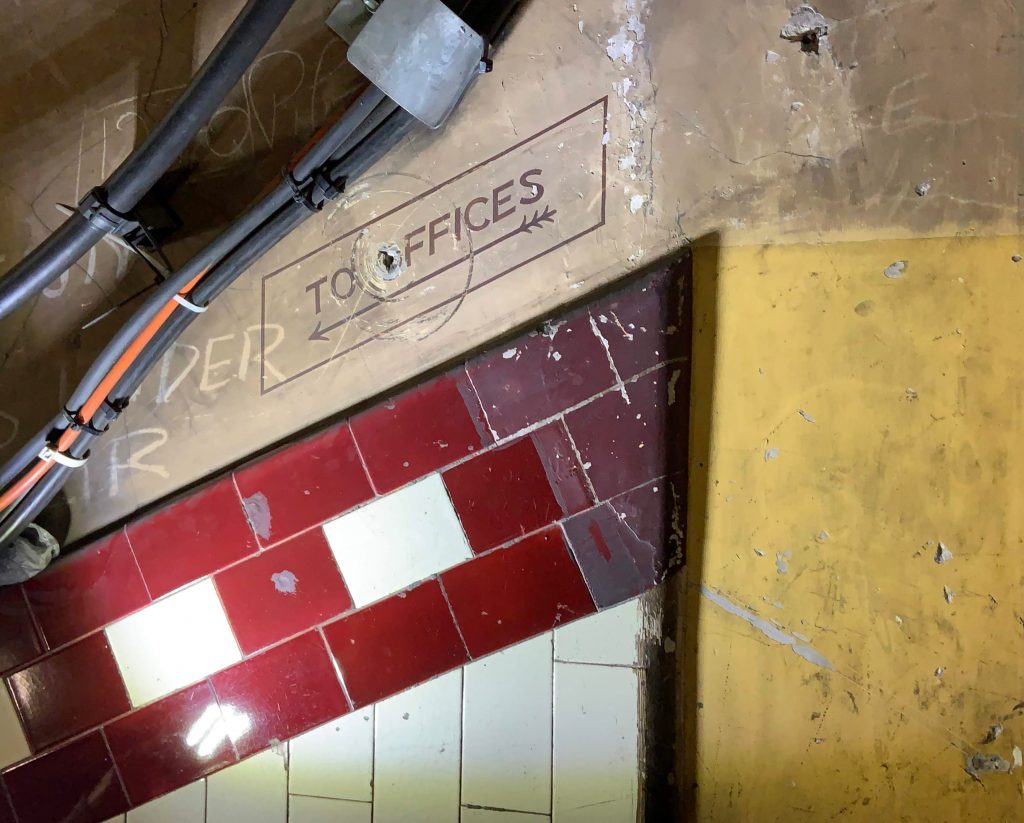
Moved in From 1935
40 staff worked here, including 8 female typists, plus phone operators and schedulers. Work continued for 24 hours a day so staff stayed for 2-3 weeks working 12-hour shifts.
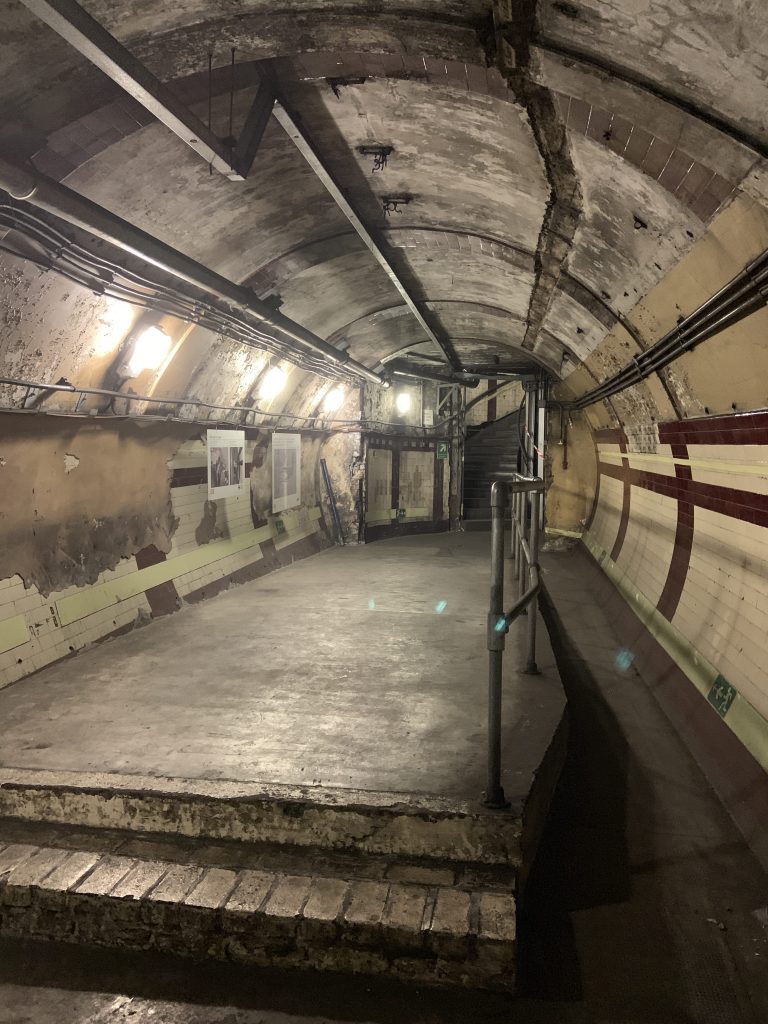
When the REC first moved in there were only chemical toilets but proper toilets, sinks and bathrooms were soon installed. The class system was alive and well in the 1940s so there were Executive bathrooms and staff toilets and sinks. A memo has been found for an order of 12 fluffy red towels from Harrods for the Executive bathrooms (for the 12 Executives who worked here).
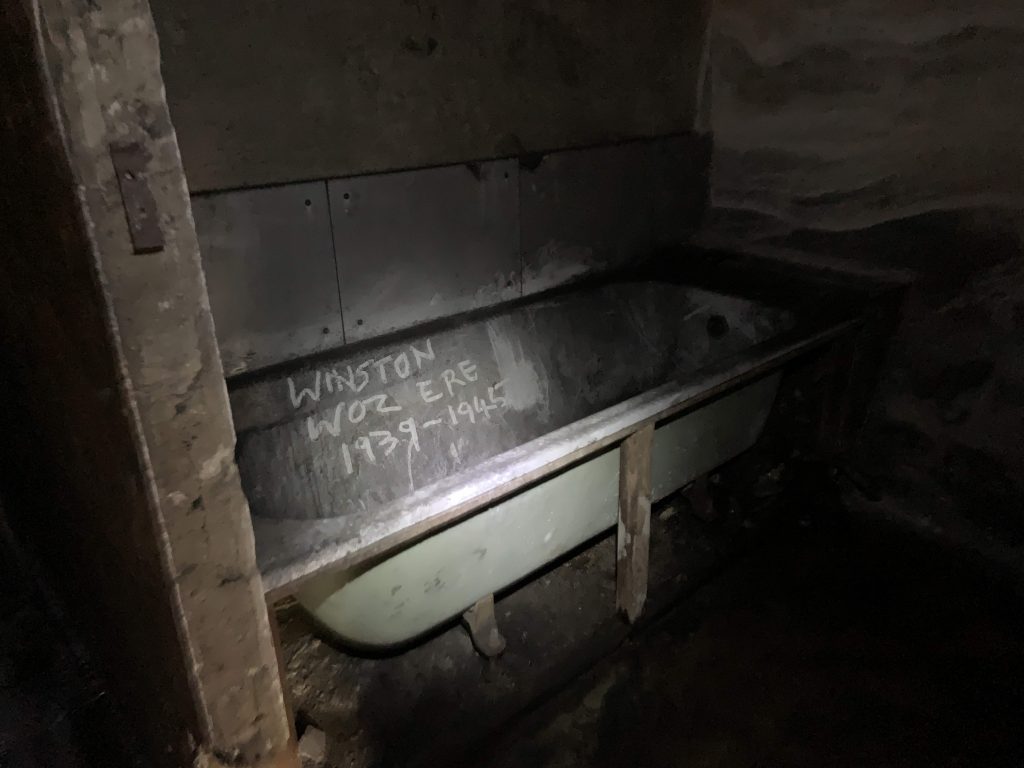
There were nineteen staff dormitories, eight of which accommodated three people in shared, tiered bunk beds. Executives had private rooms and the furniture came from London railway hotels.

Executive rights also meant they could stop a train (by switching on a red light to alert a driver) and leave the ‘offices’ by train instead of climbing up stairs to ground level. There was a lift but reports mention it getting stuck some times.
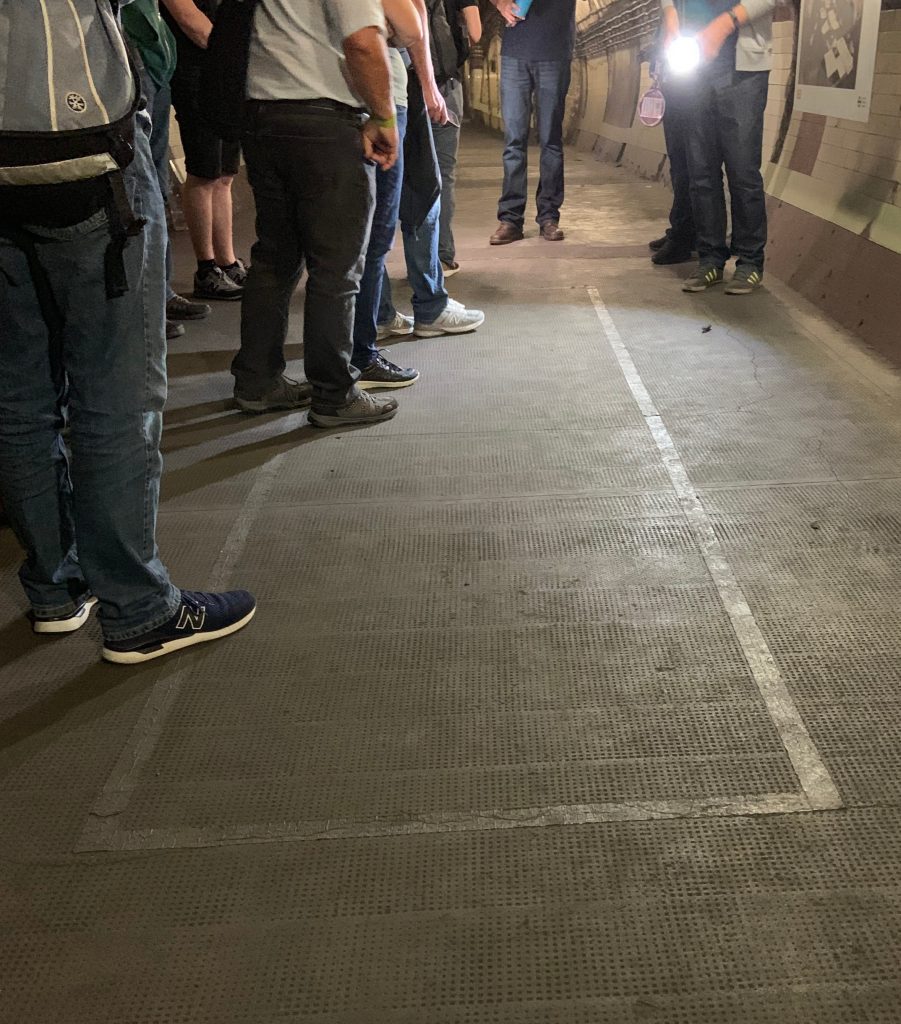
There were kitchens down here with a Head Chef and two assistants, plus a couple of waiters. (There’s a vent in the kitchen ceiling but no-one has yet worked out where it leads to.)
It was considered a privilege to work here as you were ‘off rations’ so enjoyed a better diet than your family at ground level. In the Executive Dining Room you can still see a bell on the wall for calling a waiter so they didn’t stay in the room and hear private conversations.
There were no reports of rats and mice at the station (which is astonishing as mice live at most stations now) but there are reports of cockroach infestations.

Prime Minister Winston Churchill secretly took refuge here at the height of the Blitz.
I was surprised to hear that the Cabinet War Rooms wouldn’t have survived a direct hit from a bomb above during the Blitz (it was later strengthened) but Down Street station was safe as it was so far underground and had been reinforced. Winston Churchill was friends with Josiah Wedgwood, brother of Sir Ralph Wedgewood, the REC Chairman, which is how the idea of staying at Down Street station for safety came about.
Churchill stayed in Cole Deacon’s office (REC Secretary) for 40 nights between October and December 1940 during the Blitz. He mentions Down Street in his memoirs and refers to it affectionately as “The Burrow”. Apparently, those who worked here referred to it as “The Dungeon”.
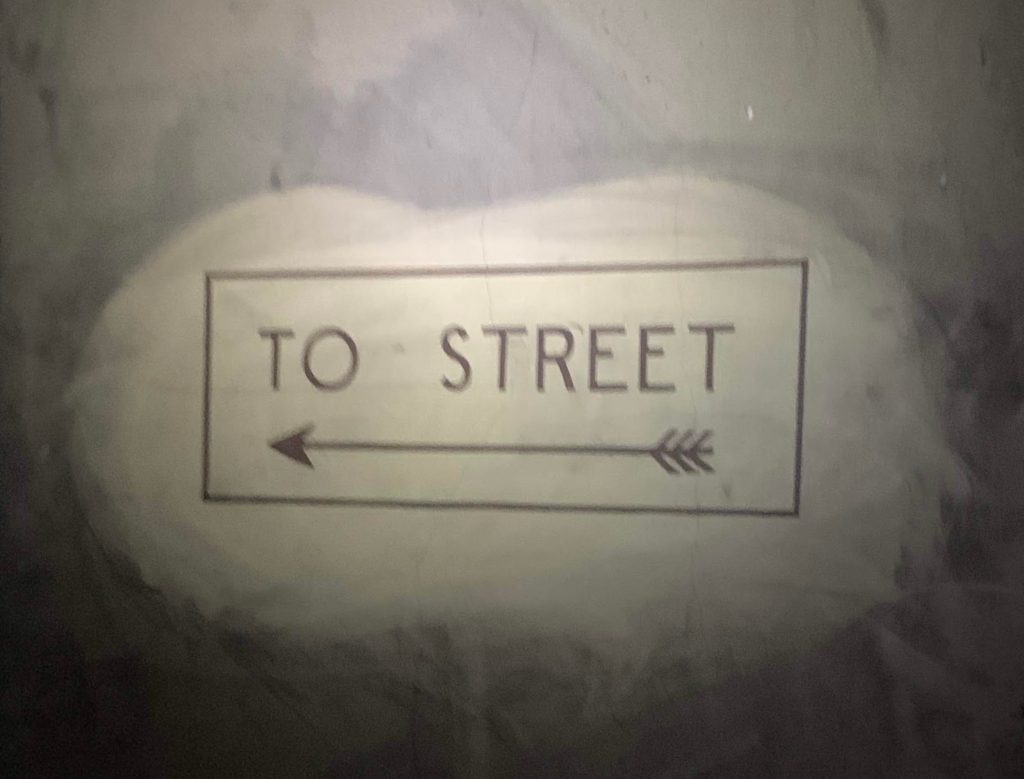
The REC was able to keep working unhindered by air raids above. A high explosive bomb did fall on Down Street (not a direct hit on the station but on the same road).
The success of Down Street station as offices was demonstrated by the REC’s decision to remain at the site beyond the end of the Second World War. The REC finally left on 31 December 1947.
The station was returned to its previous purpose to help ventilate the Piccadilly line. Little is known about the station from 1947 until the London Transport Museum started their Hidden London tours a few years ago.
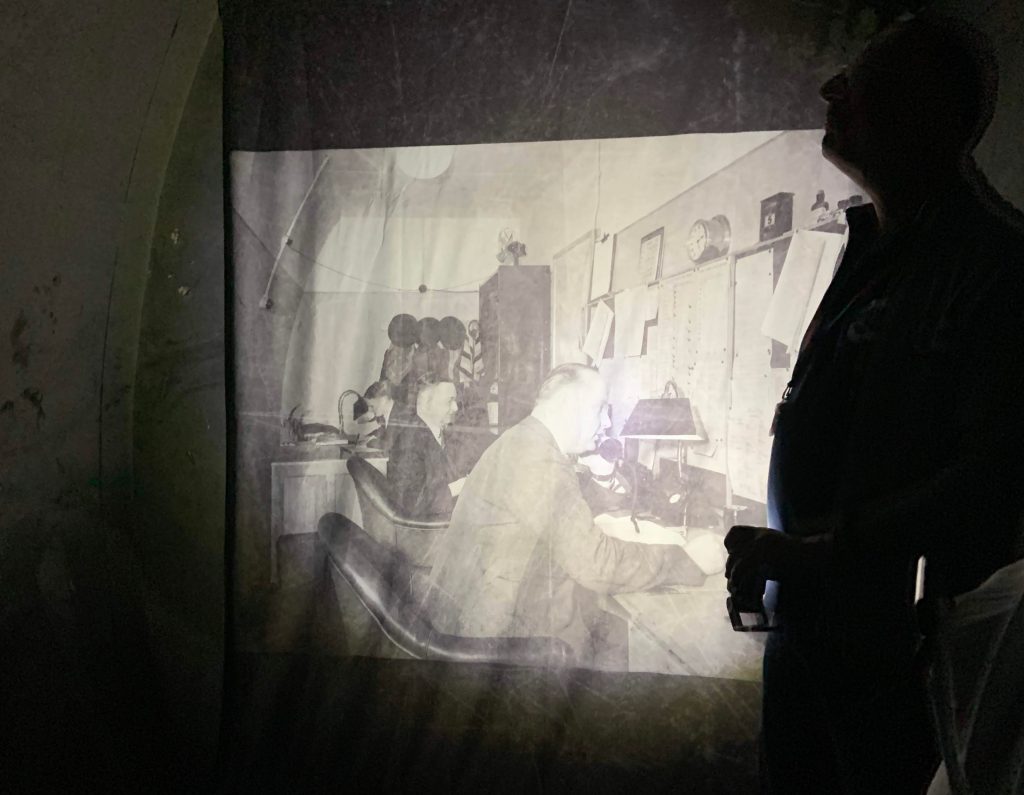
The dark and dirty warning on this tour is appropriate. We were issued with TFL-approved torches and, because of the proximity to live tube lines, there were moments of total darkness. “TOUR STOP, LIGHTS OUT” was called so we turned our torches off and stood still so as not to startle the passing Piccadilly line drivers.
Everything is covered in a thick layer of dusty grime so do not touch the walls. Apparently, 70% of the dust found in these abandoned stations is made up of human skin and hair.
The tour starts in a nearby building for the health and safety briefing and then it’s 103 steps (23 narrow straight steps and then 103 on the spiral staircase) to get around 22 metres (72 feet) below Piccadilly.
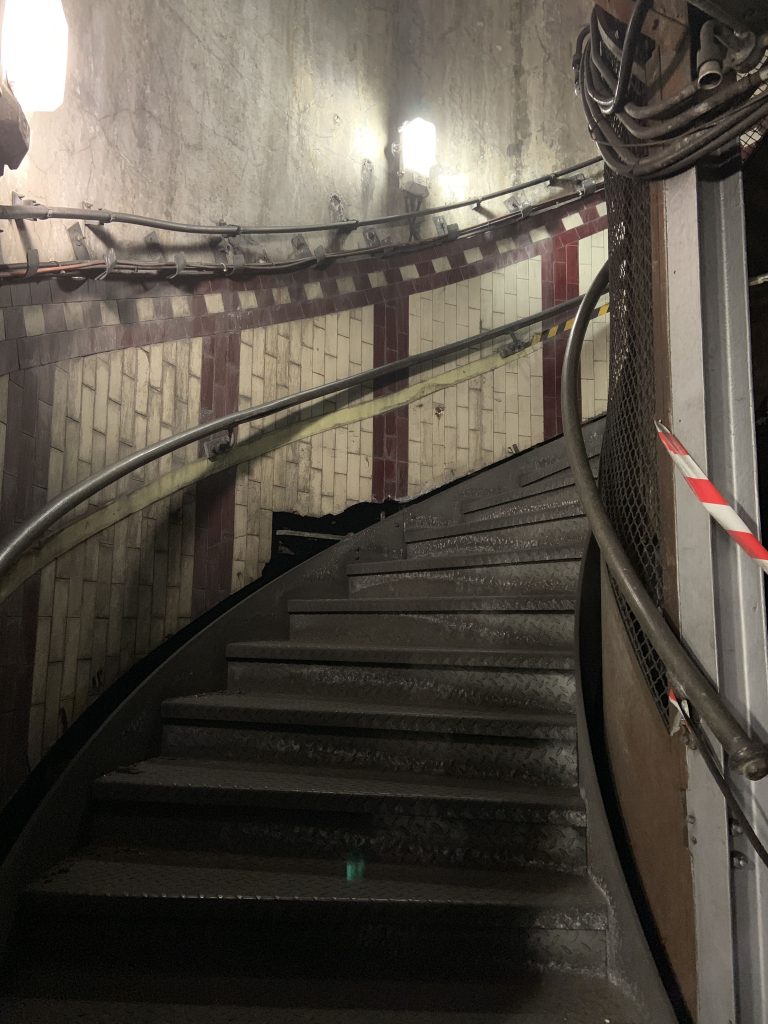
The trains can be heard nearby but are really close when you get to the rooms that are actually built on the platforms. Only a thin wall separated these rooms from the Piccadilly line track. The trains passing do not slow down as they would for a passenger station so the woosh sound of a full-speed train is quite different.
It was easy to forget you were on the tube platform so the Way Out cartouche was a good reminder.
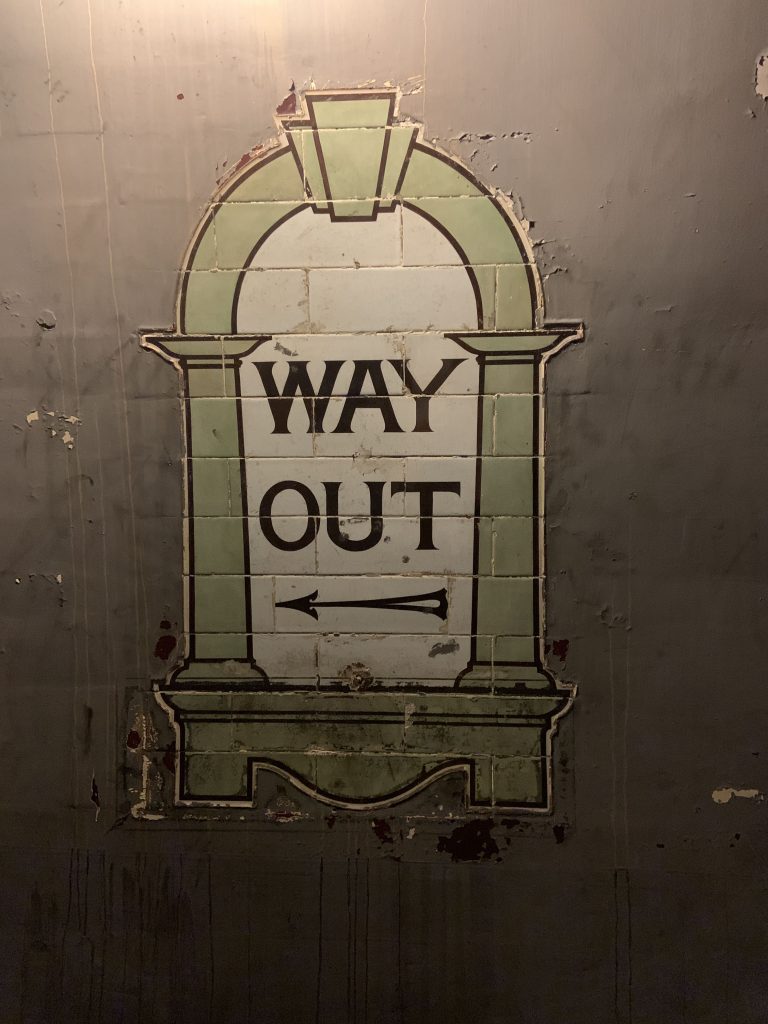
I wasn’t expecting to see a 50-line telephone exchange but it had to be in central London and here was safe – even if somewhat noisy from the close Piccadilly line trains. The telephone lines were needed for vital coordination of a railway system under fire. There was also a link between here and Selfridges for American communication.

The platform on the other side had duplicators (photocopiers) and a teleprinter. Motorbike dispatch riders waiting in the Mews at street level.
It was incredible to be so close to trains that sped past on the other side of a grill. Do look out on the right-hand side of the train when you travel between Hyde Park Corner and Green Park on the Piccadilly line as you may spot the station and see a tour group looking back at you.
Another unusual find, not at any other stations, is the tiles marked with the manufacturer’s name: Simpson & Sons.
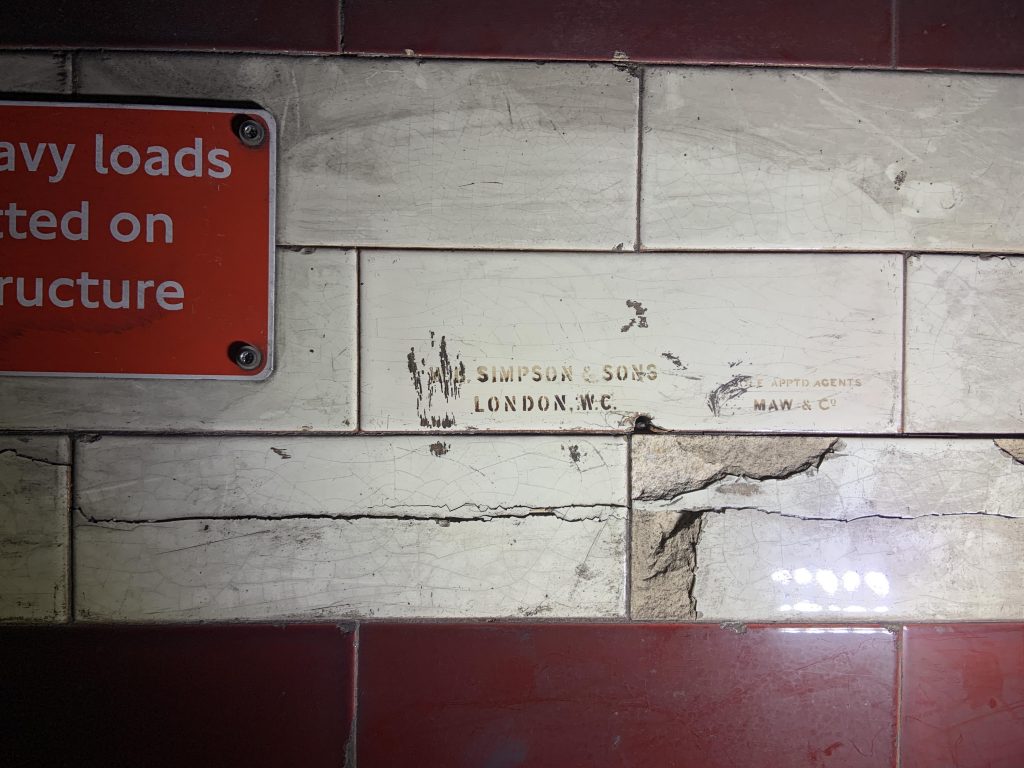
Tour Information
Our Guides were Nigel and Ben. At the end of the tour, Ben told us it was his first tour and, while he had said he was new and still learning, he was clearly already doing a great job.
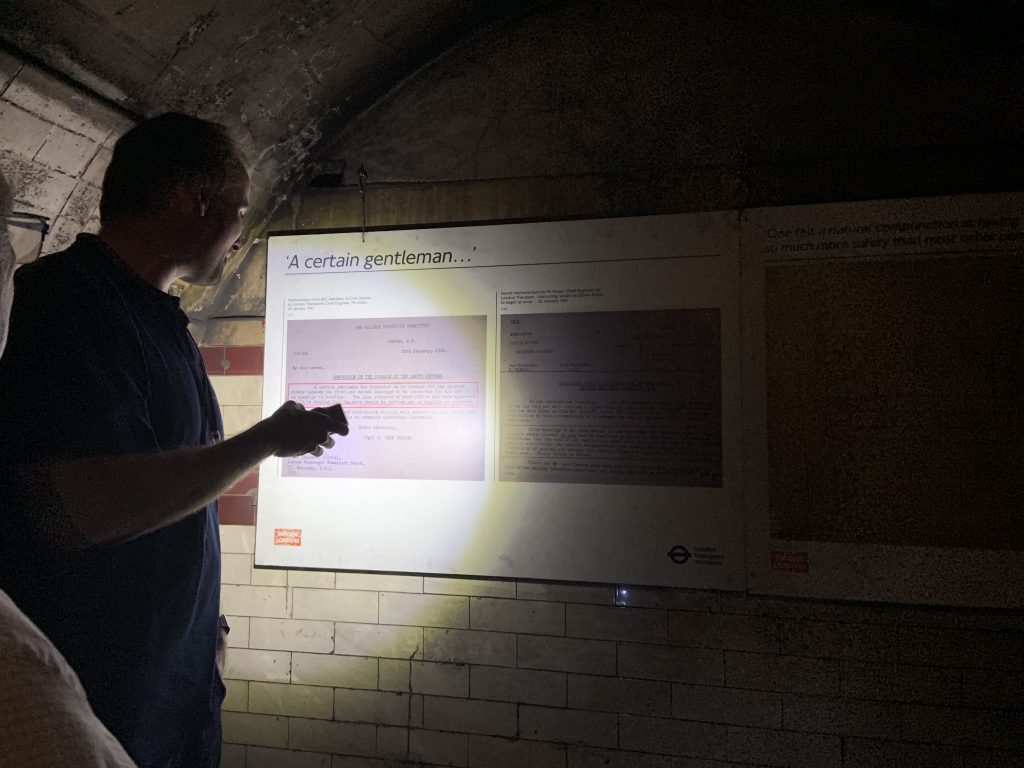
After climbing back up to ground level, we handed in our torches and everyone on the tour was presented with a ‘Top Secret’ folder produced by the London Transport Museum with fascinating information about Down Street station.
Tours do not run every day and you do need to book well in advance. Tickets are limited to a small group (12 places available on each tour).
Official Website: https://www.ltmuseum.co.uk/whats-on/hidden-london/down-street
Sign up for the London Transport Museum newsletter to be first to hear about Hidden London tours.
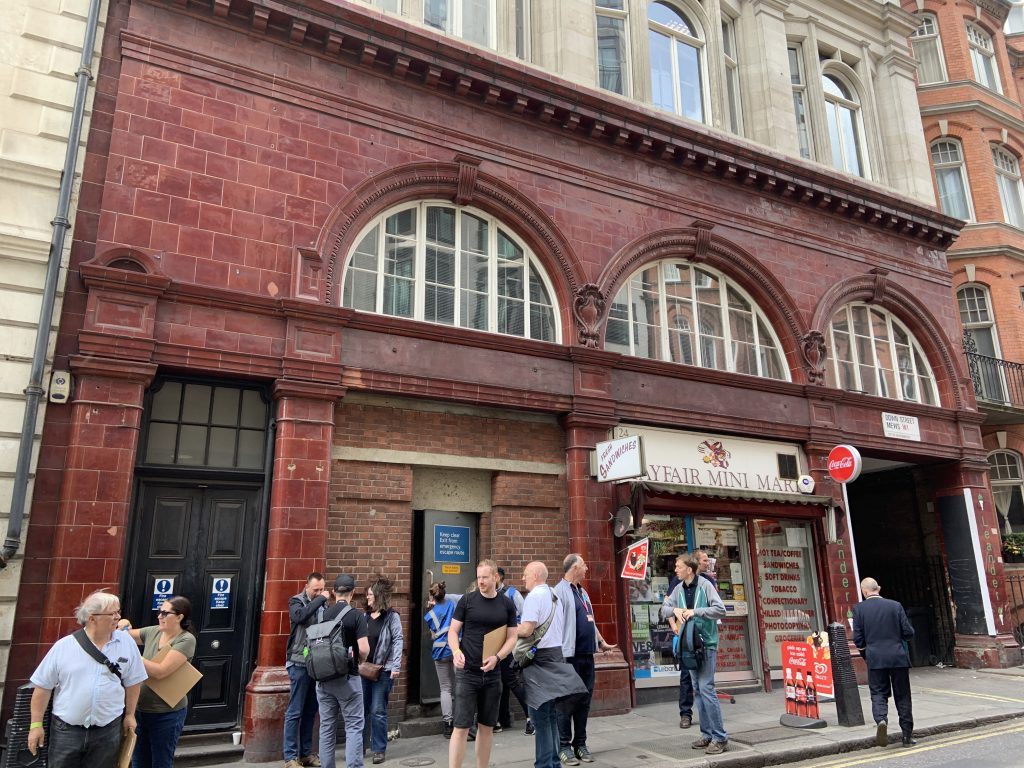
We were told a new Hidden London tour is coming soon which is exciting news as I’ve now been on all the underground tours available.
Disclaimer: As is common in the travel industry, the writer was provided with complimentary tickets for review purposes. While it has not influenced this review, AboutLondonLaura.com believes in full disclosure of all potential conflicts of interest.
Down Street station ‘Hidden London’ tour – London Transport Museum

Down Street tube station, situated in a side street in Mayfair, is easily missed. This was one of the reasons why it had such a short life as a fully operational station. Fortunately, when taking one of the guided tours, you don’t have to try and find the station as the starting point is inside the Athenaeum Hotel on Piccadilly.
The ‘Hidden London’ tours of Down Street are billed as a chance to see where Winston Churchill sheltered during the Blitz, but Britain’s wartime Prime Minister played only a small part in the station’s story. The tour includes plenty of anecdotes about how the building has been used and there is a lot to see. Inside the hotel, I met up with the tour guides and my fellow visitors and we were soon finding out more about the early history of the station.

Opened in 1907, Down Street station was always an anomaly and rarely busy. This was mainly due to its quiet location and proximity to two other stations on what became the Piccadilly Line, Dover Street (later renamed Green Park) and Hyde Park Corner. Another factor was that many of the affluent local residents didn’t use the Underground themselves and disliked the station, fearing it would bring an influx of ‘undesirables’ to their neighbourhood.
By the First World War, some trains were no longer stopping at Down Street, then the ticket hall was closed so passengers had to buy their tickets from the lift operator. It was probably no surprise that Down Street was closed completely in 1932 after only 25 years of service. But, seven years later and because the station was built deep under the city, Down Street found a new lease of life. It became the headquarters of the Railway Executive Committee (REC) which was a wartime collaboration between Britain’s four main private railway companies.

The tour proper begins at a nondescript door within what is now the slightly scruffy frontage of the former station. Yet, I still felt a sense of excitement about entering through a door that only a few can access. Once inside we descended via the circular stairwell until we reached a network of tunnels which in 1939 were converted into a suite of offices and living quarters. From here, for the duration of the Second World War, the REC planned and coordinated Britain’s above ground railway system. This involved the vital work of moving service personnel (fit and wounded), munitions, food and other supplies. Passengers were discouraged from travelling by train unless their journeys were essential.
The tour guides explained how each part of the tunnel network was divided up and used for working, eating, cooking, washing and sleeping. We saw evidence of the wartime changes including signage, a telephone switchboard, sanitary ware, and the outline of where clocks had once been positioned. In some of the rooms, evocative period photos were on display, and I began to think about what life must have been like in this intense and cigarette smoke-filled subterranean world. The clocks were particularly important as many of the REC staff stayed at Down Street for shifts lasting several weeks where day would have blended into night. Imagine not seeing daylight or breathing fresh air for so long! On the plus side, the staff were safe from the bombing, and for those from humbler backgrounds the fitted baths, hot running water and inside toilets may have been a novel and welcome experience.

Up to 40 men and women lived and worked at REC headquarters at any one time and, even underground, British class differentials were strictly maintained. The male executives sat on soft leather chairs and could go out for meetings and other business. For the rest of the staff, it was hard wooden chairs with little respite. The executives had a private dining room where occasionally they enjoyed caviar, cigars and fine brandy, all supplied by the railway companies. Here, they would have been joined by Winston Churchill on the nights he slept over at what he called ‘the burrow’ during the height of the Blitz in late 1940. At a time when Britain’s survival was so uncertain, the safety of the Prime Minister was paramount.
Throughout the tour, we could hear the distant rumbling of the Piccadilly Line trains. Then, after descending a short flight of steps, the volume increased as we were level with the tracks and only separated from the trains by metal cage doors. The walls of the headquarters were built directly on the platforms, so you have to know exactly when to look when speeding in the dark between Green Park and Hyde Park Corner. Yet, once you know the station is there, I guarantee you will try and spot it.

As the 90-minute tour of this ghost town-like station came to an end, we ascended the stairwell and exited through the small door to the street, leaving Down Street to its main purpose these days of providing ventilation for the Piccadilly Line. Having been temporarily transported back to the 1940s, it felt odd stepping out into 21st Century Mayfair with the warm lights of the Athenaeum ahead of us. As we said goodbye to our excellent guides who were knowledgeable, enthusiastic and had been happy to answer questions, I began planning my next ‘Hidden London’ adventure.

Wear comfortable shoes and darker coloured clothing. Down Street station is dusty, and you are likely to brush up against some of the walls.
In addition to your tickets, you will need photo ID. The tours are adults-only, and tickets also include free entry to the London Transport Museum within 30 days of your tour.

Visiting and access information
Check the website for availability for Down Street and other ‘Hidden London’ tours including Charing Cross, Clapham South, and Moorgate. Prices vary between the different tours and pre-booking is essential.
The Down Street station tour is not suitable for everyone as it includes many steps, some uneven floors, narrow corridors and small rooms. The light varies from dark to quite bright, and you will hear the noise of nearby trains. Toilets are available at the beginning and end of the tour but not once you enter the station. The maximum group size is twelve visitors.
Acknowledgements and image credits
This article reflects my own views, but I should acknowledge and thank Ollie Burton, Head of Hidden London, as well as the professional and engaging tour guides Pat and Gillian and customer service assistant Neil. All images are courtesy of London Transport Museum.
* * *

Ian Lacey is a public historian. He is currently undertaking postgraduate research at Royal Holloway University of London into the experiences of UK travellers who went Interrailing between 1972 and 1990. Ian has worked in the visitor attraction sector for the National Trust at Osterley Park and House, and most recently as Marketing Manager at the Houses of Parliament where he was responsible for promoting tours and visits. Aside from history, Ian’s interests include travel and tourism, accessibility, photography, music, and cricket. Twitter @ian_lacey
- Czech Republic
- The Netherlands
- South East England
- North West England
- South West England
- East of England
- City Break Guides
- Foodies Guides
- Travel Tips
- Travel Feels
- Travel Help
- London Living

Down Street Station Tour – Churchill’s Secret Station
- January 17, 2017
- 15 comments
- 5 minute read
My friends and family think I’m bonkers, and can’t understand where my obsession has come from – but I’m nuts about the tube. Not riding on it you understand. I loathe my commute with every fibre of my being. But the history and uniqueness of it – that is my bag entirely. And it is in that vein that I found myself in an online queue 8 months ago trying to buy tickets for the one thing I’ve been excited to see for years – Down Street, known as Churchill’s secret station.
You see, I’ve got this thing for abandoned, secret places in London and tube stations rank highly on the list. I’ve already seen Aldwych , but none of the other secret stations appeared to be any closer to opening. Until last year. The Hidden London series of events got started and I purchased my golden ticket.
So what exactly happens on a Down Street station tour?
Early beginnings
First things first – what is the deal with Down Street? Well here goes. As a tube station, Down Street was completely useless. Situated between Hyde Park Corner and Green Park stations in Down Street, it was a working station from 1907 to 1932. Barely visible from the main road of Piccadilly, Down Street was an unpopular station right from the get go – the upper class residents of Mayfair didn’t want it so signage from the main road wasn’t permitted, and they didn’t need it either as they largely had their own transport. It was finally killed off in 1932 because of lack of use and that was to be the end of Down Street.

Down Street was a particularly difficult station – it was delayed in opening due to difficulties in getting the appropriate permissions to use the land and because of disagreements over the safety of passages deep underground. It has a complicated layout because of this, which made it difficult for passengers. Hardly an ideal tube station.
The war years
But the Piccadilly Line’s loss was in fact the war efforts gain – and this is why the station is so intriguing to tube and war history geeks alike. Because Down Street was to get a fairly major role in protecting government operations from bombing in the event of war, and specifically was used by the Railway Emergency Committee. The REC controlled the operation of Britain’s Railways during the war (including ensuring vital supplies and medical staff could use the railways unhindered), and in 1939 the enclosed platform areas and space in the passages were divided up into offices, meeting rooms, toilets and dormitories. It even had a telephone exchange.

During the war up to 8 secretaries and countless REC staff used the space round the clock and often had to stay underground. As well as the REC, it has been rumoured (although not definitively confirmed) that prime minister Winston Churchill and his war cabinet had space there, and we do know that Winston Churchill stayed overnight in one of the REC rooms during The Blitz.
However, since the end of the war it has been used only as an emergency exit from the Underground.
Post war + dismantlement
Sadly, at some point after the end of the war and present day somebody thought it was a good idea to dismantle all that had been modified as part of the REC requirements. Partition walls have been removed, toilets dismantled and even the telephone exchange has been painted over in a deep grey. Even down to the wires. All that is left now are little snippets of what it might have looked like during this time – a mark in the wall where a clock might have been, or the raised floor of a meeting room. In one of the old rooms remains a bath.

Unfortunately no one knows why or when this took place.
Going on a Down Street Station Tour
I attended a station tour in early December (after booking my tickets all the way back in May!) on a cold bleak Sunday evening (which felt appropriate given the fact we’d be visiting a ghost station!). We met at the Athenaeum Hotel just round the corner and were given a safety briefing and a torch. This already felt a lot more “edgy” (edgy? I can’t believe I have described a London tube station tour as edgy) than my tour of Aldwych.
After entering the station (which is visible from the street, noticeable only by the beautiful red tiles that are typical of a Leslie Green designed station), we started our ascent down the emergency spiral staircase as the lifts had long been removed. Within the station itself is a glorious mishmash of history – original tiles which can still be seen in other Piccadilly Line stations, 1930’s signage and then of course evidence from the war years. This included really quite hideous ochre coloured paint, arrows and signs that bear no resemblance to typical tube station design. On top of that there were also some modern signs to help with its current function as an emergency exit.

During the tour we were led around passages and given the history of what would have happened whilst the REC were there. The typing pool, the meeting rooms, the telephone exchange, the kitchens and the dormitories. The space was tiny and I couldn’t ever imaging working there. Particularly as only a small thin wall separated these rooms from the Piccadilly line track. Throughout the tour as we used our torches to navigate the dark damp passages we were told to “STOP TOUR, LIGHTS OUT” so as not to startle the passing Piccadilly Line drivers.
Believe me when I say there is nothing more terrifying than having to stop dead still in the pitch black whilst a train speeds just past your nose.
After years of wanting to see inside this intriguing station I wasn’t disappointed. It was everything I wanted it to be and so much more. And as an aside, the volunteers that lead this tour are absolutely amazing. Clearly passionate about the tube and its history, wanting to preserve it for future generations. I’ve totally found my next volunteering role (and I’m not even joking).
Want to see for yourself?
You can buy tickets for this tour via the London Transport Museum . It is expensive, but if you are curious don’t let that put you off. The tour size is small, and because of its proximity to the working Piccadilly line, safety requirements and a large number of staff are required to go with you.
Want to see inside but don’t fancy the visit yourself? The Londonist (my favourite site for quirky London facts) have made this video so you can get a peek inside too!
Are you inspired to find out more about the world beneath London’s feet?
Need MORE geekery?
If you want to find out more about the history of Aldwych and all its quirks as well as the Tube network as a whole, I’d totally recommend getting on these book, STAT.
- London Underground by Design by Mark Ovenden
ENJOYED THIS POST? PLEASE PIN IT!

Looking for part-time travel, but full-time fun?
Subscribe, and every fortnight you'll receive inspiration for gorgeous city-breaks, UK travels and offbeat experiences, alongside my own musings and tips on travelling with a full time job.
Input your search keywords and press Enter.
Down Street

Top ways to experience nearby attractions

- Hyde Park Corner • 5 min walk
- Green Park • 6 min walk
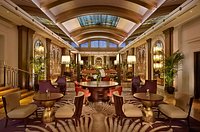
Most Recent: Reviews ordered by most recent publish date in descending order.
Detailed Reviews: Reviews ordered by recency and descriptiveness of user-identified themes such as waiting time, length of visit, general tips, and location information.
Also popular with travellers
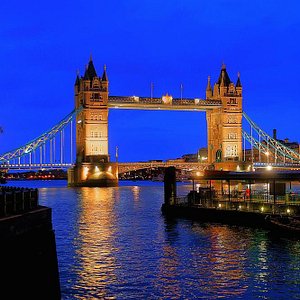
DOWN STREET: All You Need to Know BEFORE You Go (with Photos)
- Sun - Sat 10:00 - 18:00
- Thu - Thu 18:30 - 21:00
- (0.02 mi) Luxury One Bedroom apartment in a beautiful red-brick Victorian townhouse
- (0.02 mi) Have your own front door in Mayfair with our beautiful new luxury 1Bed residence
- (0.03 mi) The Athenaeum Hotel & Residences
- (0.03 mi) One Bedroom Apartment in the Heart of Mayfair
- (0.10 mi) COMO Metropolitan London
- (0.01 mi) El Pirata of Mayfair
- (0.02 mi) Afternoon Tea at the Athenaeum
- (0.02 mi) The Damask Restaurant
- (0.02 mi) El Pirata of Mayfair
- (0.03 mi) COYA

Posted on Published: 12th August 2022 - Last updated: 15th August 2022 Categories London History
By: Author Lauren Kendrick
Time to Discover: Down Street Station – Winston Churchill’s Abandoned Tube
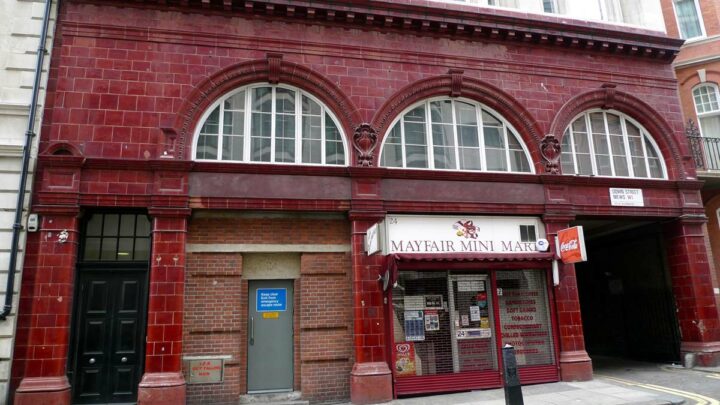
Love This? Save and Share!
Discover Down Street Station, London’s abandoned Tube Station with a bizarre AF history. Let’s go.
Ever heard of Down Street Underground Station? Don’t worry – we hadn’t either until we stumbled across it on the interwebs.
That’s because it’s London’s long-lost tube station with a secret second mission.
After a strange few weeks of obsessing over this secret tube station, we finally know all there is to know. And we’re going to share our knowledge with you. You’re welcome.
We’re going to give you the total lowdown, just in case it pops up on any annoying pub quiz question… or you want to knock out some fun facts about London’s underground and politicians getting together in tube-shaped rooms.
Ready to explore?
The History of Down Street Underground Station
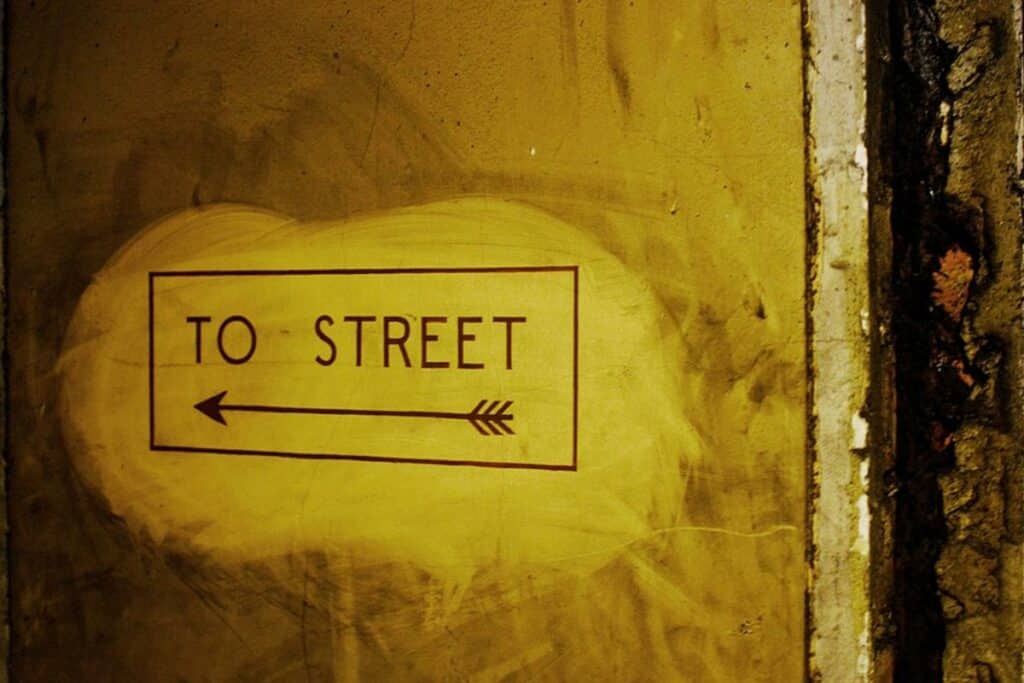
Opened in 1907, Down Street Tube Station was like many others. With its very distinctive oxblood tiles, it featured the typical design by Leslie Green – the in-house architect of all Undergrounds in the 1900s.
Yet somehow, compared to the other stations, Down Street was never busy. It was pretty close to Dover Street (these days known as Green park) and Hyde Park Corner stations.
Maybe the reason why it wasn’t busy was that everyone who had enough money to live in that area probably had chauffeurs or some other private transport.
Anyway, it ended up closing in 1932 because no one ever really used it.
So What Happened Next?
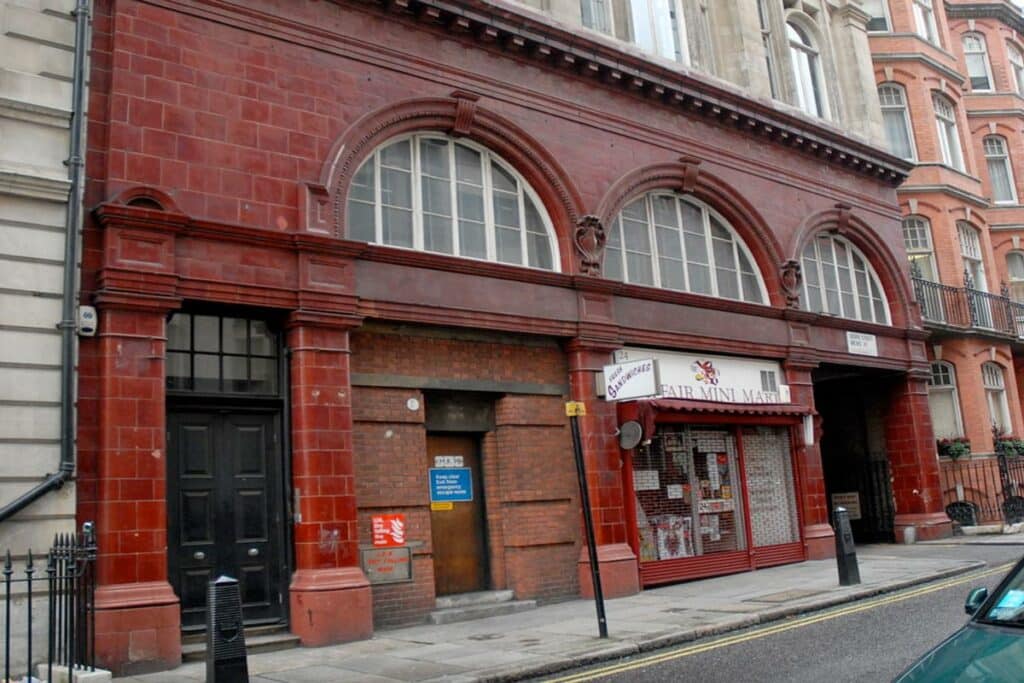
Well, this wasn’t the end of Down Street station because the exact reasons why it closed made it a great place for a different purpose in the Second World War.
Fast forward to 1938 and the Railway Executive Committee came into action to run Britain’s mainline railways in wars. They didn’t have a central headquarters in case of air raids, and with Down Street being closed down within 22 metres of the underground and in a relatively-central location – it was the perfect place!
And that’s just how it happened, the narrow tunnel of Down Street station got converted into different rooms: Meeting spots, offices, telephone exchange areas, as well as accommodation for 40 staff including dormitories, bathrooms and dining rooms.
The people there worked around the clock to avoid getting caught coming and going and revealing the secret spot, and in fact, most of the staff never even left. They lived, ate and slept in shifts – all underground!
The entire management of our country’s railways and the movement of troops was going on at that station and continued to do so until 1947.

Churchill’s Stay Down Under
During the air raids of the Blitz in 1940 and 1941, Winston Churchill actually used the old tube at Down Street as a safe haven.
When Downing Street was undergoing repairs, Churchill was rushed over there because it was the safest place for him to be.
During 1940, Churchill even went down to have dinner with members of the REC and War Cabinet in the executive room. Despite being in the middle of a raging war and the entire country locked up and rationing, it was said they were served cigars, vintage champagne and caviar!
Politicians seemed to have always had their own rules…
Fun Facts about the Secret Hideaway
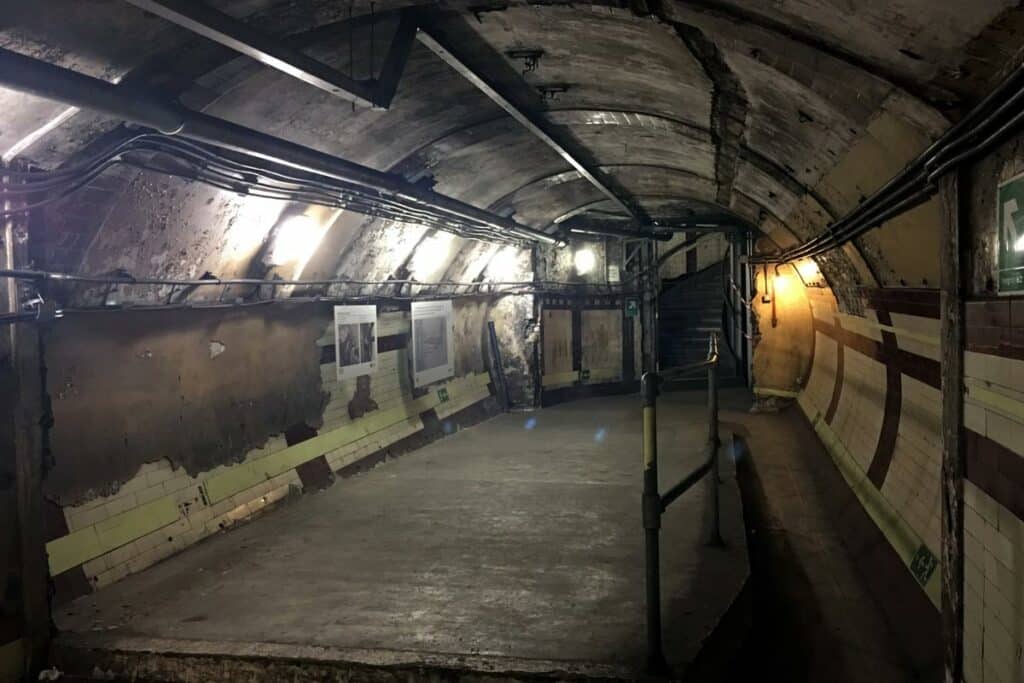
Remember the series Neverwhere ? Well, it might be a little bit niche but Down Street station was actually the inspiration for the entrance to an underground labyrinth in the series.
The video game ‘Shadow Man’ also took inspiration from Down Street (although, the version they used was far bigger than the real one) as Jack The Ripper’s hideout. As well as this, the British horror film Creep was also set in Down Street station, although the real shots were from Aldwych station.
Although, our favourite fun fact about Down Street Station has to be from the song Hefner released (called Down Street) which tells the story of two people falling in love who meet at the station. ‘Cos nothing says romance like a claustrophobic tunnel and Winston Churchill, right?
Down Street Tube Station Today
These days, the station isn’t used for a huge amount. It’s mostly used for engineering access and an emergency exit point from the Underground as well as tours through the ‘Hidden London’ programme.
Compared to its vast history and all of the incredible conversations and decisions that were probably made at the tube station, it’s quite sad that the stop isn’t used for more.
However, in April 2015, Transport for London did announce that it was looking for proposals for the commercial use of parts of the building. So, who knows what’s next for the Down Street disused tube station?
Maybe a restaurant? A bar? A theatre? Fingers crossed for a cool new restaurant.
Tours of Down Street Tube Station
Want to have a look for yourself? Well, you can. The amazing tube stop that was a critical part of Britain winning the Second World War is open for 90-minute tours. Keep your eyes peeled here for new tour dates.
Experience the super cool narrow tunnels where all the nation’s railways were coordinated and then explore the area, perhaps ending in a lovely afternoon too at a nearby Mayfair hotel.
Visiting Down Street Tube Station is a must-see in London and a huge part of our history.
Down Street Station: Map
Down Street Station: Read More London History Guides
- Who is The Golden Boy of Pye Corner?
- Queen Caroline’s Sunken Bath: What You Need to Know
- Exploring Erno Goldfinger’s 2 Willow Road
- The Hidden Secrets of Cleopatra’s Needle

LET'S GET SOCIAL!
London x London is the insider’s guide to discovering the best of London.
We delve into the cool, interesting and quirky spots that make London such a dynamic city, telling you the best things to do, eat and drink along the way.
Tired of the same old dull suggestions? Want to know where to find London’s secret bars, tastiest eats and weirdest finds? We provide practical guides that help you do just that.
Find Out More
Recently Published
- Eltham Palace: Discovering South London’s Gorgeous Art Deco Secret
- Staying At: The Laslett, Notting Hill Review
- Carreras Cigarette Factory: A Curious Reminder of London’s Egyptian Art Deco Craze

So Why Were Horses Running Loose Around London, Covered In Blood?
Several horses were seen running through central London on Wednesday morning, leaving the general public pretty mystified.
Unfortunately, four people ended up being injured and taken to hospital, and the police had to try and track down the animals before they ended up causing even more harm.
Here’s why the horses were on the loose – and why one was covered in blood.
Where did the horses come from?
The five escapees came from the Household Cavalry, which is made up of the two most senior regiments in the British Army – the Life Guards and Blues & Royals.
According to the Cavalry’s website, these soldiers “have acted as the monarch’s trusted guardians, as well as being the public face of the British Army both at home and abroad”.
A group of seven horses and six soldiers were out for their morning exercise in Hyde Park Barracks when the trouble began and four of the riders were thrown off their horses.
Five horses ended up escaping, having been spooked by building work.
Where did they go?
Moving away from Hyde Park Barracks, the horses ran through Belgrave Square – injuring two people – then went down Lower Belgrave Street.
Passers-by caught the first horse when it collided with a car on Buckingham Palace Road.
The remaining four horses continued running, with one hitting a tour bus.
Witnesses said one then crashed into a taxi outside Clermont Hotel and broke its windows – which is why it was covered in blood.
The blood was actually the animal’s own; according to a driver who spoke to LBC, the horse had cut itself when it went careening into his car.
The owner of a silver Mercedes-Benz people carrier, Faraz, said a white horse smashed into his windscreen when he was picking up a client outside Clermont Hotel near Victoria Station.
Four people were treated by ambulance workers in three separate incidents – Buckingham Palace Road, Belgrave Square and the junction between Chancery Lane and Fleet Street – triggered by the horses spread across just 10 minutes.
Were the horses captured?
All five were caught pretty quickly, although the horses had run pretty far in that time – two of them were found in Limehouse, five miles away from the origin of the incident.
Westminster Police posted on X (formerly Twitter): “We’re pleased to confirm that all of the horses have been accounted for. We are continuing to liaise with the Army.”
- Liz Truss Gives The Internet A 'Gift Of A GIF' For The Ages On Fox News
- Poll: Sadiq Khan Holds 'Commanding' Lead In London Mayor Race
- Esther McVey Reportedly Claims £3k Per Month For London Rent – Despite Husband Owning Nearby Flat
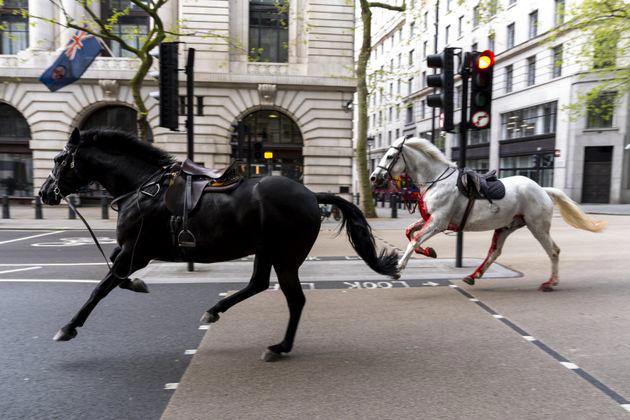
Naked cruise to sail from Miami in 2025

MIAMI (Gray News) - A nudist adventure awaits with the Big Nude Boat cruise scheduled to sail from Florida next year.
Bare Necessities Tour and Travel announced its newest nude cruise will be the Norwegian Sky cruise ship out of Miami.
The Big Nude Boat 2025 cruise will be a 10-day trip taking travelers to the Caribbean with scheduled stops that include the Bahamas, Puerto Rico and St. Lucia.
Bare Necessities said it will be taking over the Norwegian Pearl from Feb. 3 to Feb. 14, 2025.
According to the cruise itinerary , clothes-free experiences will be planned throughout the trip including nude beach days on private islands and nude days at sea.
But there will also be proper nudist etiquette and other rules for guests on board that include no photo zones around the pool area and dance venues, according to the cruise’s policies .
The travel company recommended that passengers bring some sort of casual clothing for the times they need to dress, along with a swimsuit as not all excursions will be clothing optional, but lingerie or fetish wear will not be an acceptable form of clothing on board.
The Big Nude Boat 2025 cruise tickets are currently on sale with prices starting at $2,000 for double occupancy.
Information about costume parties and onboard events is expected to be released at a later date.
Copyright 2024 Gray Media Group, Inc. All rights reserved.

‘So sorry for the screwup’ Normangee theft slips through the cracks as statute of limitations expire

Police investigating fight on Bryan High School campus

Blast to the past: La Bodega is coming back!

College Station City Council considering paid parking for events

Law enforcement activity shuts down street in Bryan neighborhood
Latest news.

Tornadoes collapse buildings, level homes in Nebraska and Iowa

Tennessee governor signs bills to allow armed teachers nearly a year after deadly Nashville shooting

Students lead protest against armed teachers bill

Town’s only barber retiring after 72 years cutting hair

Town's only barber retiring after 72 years
Money: '£2,000 landed in my account' - The people who say they're manifesting riches
We delve into the world of manifestation - but will a one-day course help our reporter land some extra cash and an engagement ring? Enjoy our weekend reads, and leave a comment, below, and we'll be back with all the latest personal finance and consumer news on Monday.
Saturday 27 April 2024 10:13, UK
Weekend Money
- '£2,000 landed in my account' - The people who say they're manifesting riches
- Iceland's new slogan and cash for grades: What our readers said this week
- Calculate how much your take-home pay will change this month with national insurance reduction
- Why are mortgage rates going up?
Best of the week
- The world of dark tourism - what is it, is it ethical and where can you go?
- Virgin Media customers share their bad experiences of customer service
- More Britons paying inheritance tax after chancellor freezes threshold - so how can you beat it?
- 'More important than a will': What are lasting power of attorneys and how much do they cost?
- 'I have a mortgage offer - will it change now rates are rising?'
Ask a question or make a comment
By Jess Sharp , Money team
My journey into the world of manifestation (the belief that you can attract success in your life through positive affirmations and visualisation) has taken me places I never thought I'd go.
Like woods in Edenbridge, where I stood meditating under a tree in the pouring rain. I don't yet know where my journey will end (I've been hoping for an engagement ring but my boyfriend hasn't yet seen my visualisations), but it started with a conversation with Jamie Greenlaw-Meek, one of many people who say manifestation has transformed their lives.
"About a year ago, there was something happening and I thought we just need two grand to cover the expense," Jamie, a former dancer from London, told me. "The following day £2,000 landed in my account."
It sounded like a coincidence to me, too.
But Jamie was adamant. His husband calls him "the master manifester" because of his "ability to bring in money".
"It's happened on so many occasions, like four, five times," he said. "I've become very clear on what I want and the amount of money I need and literally it can be within 24 hours that I get a phone call for a job and it's almost identical to what I asked for money-wise."
When I asked the now-psychic where the £2,000 actually came from, he said it was payment for a modelling job he had been offered.
"With manifesting you don't get caught up in the how, and often it comes in ways that you don't expect," he added, explaining it could come as the result of a claim after being in a car crash.
"It's not always coming in the way that you think but money is out there for us to take in the world. It's just having the confidence to receive it and we are worthy of it."
"Even if it is a placebo effect, does it matter?" he said.
The 43-year-old also believes he manifested his husband Fiongal after being diagnosed with cancer. While going through treatment and dating "a lot" of people, he decided to take matters into his own hands, or rather his own head, and started visualising his perfect partner.
"I decided to spend a good couple of weeks getting really, really, super clear in my mind what this person looked like. Then I started creating lists asking about personality traits, and all the things that I wanted that person to be," the former dancer said.
"The day I got the all clear from cancer I randomly met my husband and when I look at the list of the things I asked for, he pretty much ticks every single box. I really, really believe that is because I got super clear on what I wanted and I put that out to the universe to bring to me."
Jim Carrey and manifestation
If you think this is a new practice, it isn't. Jim Carrey was doing it back in the 90s. He famously wrote himself a $10m cheque for "acting services rendered" and dated it years in advance. Then in 1995, he was told he was going to make the exact amount for filming Dumb and Dumber.
The idea shot up in popularity again in 2006 after Rhonda Byrne published her self-help book The Secret.
Since then, it has hit every inch of the internet and has resurfaced on TikTok with videos posted under #manifesting accumulating a huge 13 billion views.
I tried to learn manifesting - I felt like an idiot
After hearing Jamie's story and seeing the idea was popular with so many people, I thought it best to try to learn manifestation myself. I mean, who wouldn't want money landing in their account and a work promotion from the universe?
As I stood in the woods, in the pouring rain, being told to imagine roots growing from the soles of my feet, I felt like an idiot.
I was soaking wet (of course I had forgotten a coat with a hood) and while my mind kept wandering through thoughts about being cold, if I'd hit traffic on the way home and how dirty my white trainers were getting, a gentle, soothing voice kept bringing me back to what I was supposed to be thinking about.
"How we are all connected, how the trees and plants produce oxygen that we breathe, and we breathe out carbon dioxide which they need to survive"
While some people focus their manifestation practices on being grateful to the universe, Tansy Jane Dowman believes we need to get "out of our heads, into our bodies", connect with nature and find our true selves before we can practice it successfully.
My meditation in the woods was just one part of a six-hour workshop run by Tansy, which aimed to send me off with a clearer vision of what I truly desired.
Tansy charges anywhere from £25 to £580 for her courses, which range from one-on-one sessions and an online six-week programme, to forest bathing workshops and weekend-long nature retreats.
But some courses have popped up online which cost more than £1,000.
Tansy started practising manifestation in 2018 after going through a difficult period in her life. She eventually quit her job in events management and started teaching others how to do it successfully.
"The way I manifest is not to focus on material wealth or gain. I would ask my clients what an abundant life means to them in terms of feelings, experiences, connections, people and places," she explained.
"The more authentic you are, the more of a beacon you become for those things to find you."
After spending time walking in the rain and meditating under a tree, Tansy and I sat in her dining room and explored some of the happiest moments in my life and the feelings I experienced. It became clear I like feeling accomplished, needed and excited.
We also spoke about challenging times, but the conversation focused on the positives, like how I had overcome them and what I had learned.
"It's so important to bring in your values with manifestation because sometimes we can get really confused with what we want, with social media especially," she told me.
Throughout her house, Tansy has a number of "abundance boards" proudly on display - some she has made with her children, others are from her annual January tradition of setting out her desires for the year.
"I've had some really wonderful goosebump things happen to me. I did a board at the beginning of 2020... I put a picture of a microphone on it. I just thought I really like that image and I didn't immediately place any meaning onto it," she said.
"Then as the world was shutting down for lockdown, I did a press event and I met a lady who worked for Wellbeing Radio and she wondered if I would be interested in trying out as a presenter."
She explained that some people will be very specific with their desires, like selecting a photo of the exact car they want, or the perfect house, but that isn't how manifestation works. There needs to be an element of trust in the universe giving them what they attract.
As we created my abundance board, which Tansy describes as being like a "personal algorithm", she told me to select images and words from heaps of magazines that called to me intuitively.
As you can see from the picture below, mine calls for being "financially fabulous", travelling, getting engaged (coughs loudly in earshot of boyfriend) and living stress-free.
And while I'd love a big cash injection, Tansy explained to me that money is "only a stepping stone to a feeling" and, ultimately, I'm aiming to create an emotion with it.
Manifesters more likely to go bankrupt
While all the manifestation believers I spoke to said there was no downside to the practice, a researcher has been looking into whether it really does pay off.
Based in Australia, Dr Lucas Dixon (who specialises in consumer psychology) created a scale from one to seven to rank a person's strength of belief and found those who practice it are more likely to have been victims of fraud and declared bankruptcy.
He said there was a "danger" that manifesting could become harmful if taken to an extreme level.
He found those who believe in manifesting tend to think more positively and have a confident attitude when it comes to success, and while that can be helpful in business, it can also cause them to take unnecessary risks.
"They weren't more objectively successful in terms of having higher income or higher education attainment," he said.
"We also found that they are more likely to believe in get-rich-quick schemes, more likely to take higher risks... to have risky financial investments and more likely to have investments in cryptocurrency rather than traditional stock."
Using the scale he created, Dr Dixon found those who have "very strong beliefs", ranking at a seven, were 40% more likely to have gone bankrupt.
"The danger comes in a couple of different forms," he said, explaining that a "worst case scenario" could see people getting into financial difficulty by being encouraged to "just look at the positives".
"Someone might say it's not harmful because it is really just thinking positively but I think even that can be harmful because of what you might call an opportunity cost," he said.
"You're spending time, energy and money doing something that doesn't have a lot of evidence behind it. We found it does make you feel good but you don't need to pay thousands to do it."
Okay, so back to me...
I did my manifestation course about two months ago, and I have done as I was instructed - my abundance board is up in sight inside the flat, and I often have a cup of coffee in front of it.
But, so far I'm still using a credit card, the most travelling I've done has been to work and back and there is still no rock on my finger. I have been given an annual pay rise, though, and would say I am less stressed.
Perhaps believing that I'm just doing my best and there's a chance that I'll be rewarded for that one day, eventually, in the future, maybe, is making me feel better... who knows?
Each week, Money blog readers share their thoughts on the subjects we've been covering, and over the last seven days your correspondence has been dominated by these topics...
- Iceland's new slogan
- Rising mortgage rates
- Giving kids cash for grades
Iceland's new catchphrase
We learnt on Monday that Iceland had dropped its tagline "That's why mums go to Iceland", replacing it with "That's why we go to Iceland".
The move was made to reflect the store is for everybody, said brand ambassador Josie Gibson. Readers were split - with some feeling so strongly that they're prepared, they suggest, to sacrifice those frozen Greggs steak bakes forever...
I previously contacted Iceland about their slogan because I didn't think it did single dads justice, as dads can go to Iceland too. Their response was that people understood that it's not just mums that go to Iceland. It's about time they changed the message. Dave T
Neither I, my wife or my children will shop in Iceland again due to this stupidness and woke attitude. To hell with you [Iceland boss] Richard Walker. John
Banks hike mortgage rates
This week we reported that high street lenders such as Halifax, TSB, NatWest, Barclays, Leeds Building Society, HSBC and Coventry had all hiked mortgage rates (see 7.33 post for details).
You said...
With house prices at already extortionate levels, now mortgage rates rising again, is there any hope for first-time buyers? Honestly, the situation is so bleak, people may need to consider other countries. GenZ
Why would this happen? So many young couples struggling to get on the property ladder. I live in Dorset - a one-bedroom flat costs from £230,000. In Scotland, one can get a beautiful two-bed house for that price. Feel sorry for all couples living down in the South. Need huge deposits. Barbs
Why are they called high-street banks? Most banks in my town have closed. Martin J
Parents offering cash for good grades
A lot of views came in after our feature exploring the positives and negatives of parents incentivising good school grades with cash...
We had scores of comments on this - with a fairly even split...
We did it for our son at GCSE time. We think it made a difference of about a grade on most subjects. Got a two-grade lift on maths. Cost us £350. Thought it was good value as it has taught him how things work in the world. Andy
The whole world is built on a reward system which symbolises access to money commensurate with effort and excellence. The Nobel prize goes with a cash reward! Tom Deggs
Employees are offered incentives for achieving targets, so why not offer kids incentives for better grades? Claire228
But others had concerns...
I think it puts too much pressure on kids who are under enough pressure at exam time. Parents should encourage their kids to do the best they can, not add to their stress levels. Emma
Children should value their education without it being monetised. My parents expected my brother and I to have the motivation, maturity and self-discipline to work hard for our GCSEs. We both achieved all As and A*s. Eliza
When I was at school, from 1964-83, my parents never gave me money for good exam results, because "I should want to do well for myself". No matter what my grades were, they said that they would be proud of me if I had tried my best. Cash kills self-motivation. Nicola B
National insurance was cut this month, for the second time this year, from 10% to 8% on employee earnings between £12,570 and £50,270.
The change, announced by the chancellor in his March budget, impacts around 27 million payroll employees across the UK - starting this pay day.
The cut is worth almost £250 to someone earning £25,000 a year and almost £750 for those earning £50,000
Use our tool below for a rough guide to what tax changes can be expected for most people, as there are other variables not included which might affect how much tax you pay including being in receipt of the blind person's allowance or the marriage allowance. It also assumes you are not self-employed and are under pension age...
There are also national insurance cuts for the self-employed. This includes the scrapping of Class 2 contributions, as well as a reduction of the rate of Class 4 contributions from 9% to 6% for the £12,570 to £50,270 earnings bracket.
These will impact nearly two million self-employed people, according to the Treasury.
While many campaigners welcomed the national insurance announcement last month, they pointed out that the tax burden remains at record high levels for Britons - thanks in part to the threshold at which people start paying income tax being frozen, rather than rising with inflation.
The money story of the week has been mortgage rates - with a host of major lenders announcing hikes amid fears the Bank of England may delay interest rate cuts.
Swap rates - which dictate how much it costs to lend money - have risen on the back of higher than expected US inflation data, and concerns this could delay interest rate cuts there.
US trends often materialise elsewhere - though many economists are still expecting a base rate cut from 5.25% to 5% in the UK in June.
The reliable Bloomberg reported this week: "Still, while some economists have since scaled back their predictions for BOE cuts, most haven't changed expectations for a summer move.
"Analysts at Morgan Stanley, Goldman Sachs Group, Capital Economics and Bloomberg Economics are all among those still anticipating a shift toward easing in June."
The publication also quoted Sanjay Raja, chief UK economist at Deutsche Bank, as saying: "Markets have superimposed the US cycle on the UK, but the US and UK are on very different tracks.
"The UK is coming out of technical recession. Inflation is falling more convincingly. Pay settlements are following inflation expectations. And crucially, real policy rates in the UK will be higher than in the US."
None of this reassurance changes the fact that financial markets, which dictate swap rates, are pricing in delays.
This week's hikes came from Halifax, BM Solutions, TSB, NatWest, Virgin, Barclays, Accord, Leeds Building Society, HSBC and Coventry.
This is what average mortgage rates looked like as of Thursday...
The next Bank of England decision on rates comes on 9 May - and pretty much no one is expecting a cut from the 16-year high of 5.25% at that stage.
The Money blog is your place for consumer news, economic analysis and everything you need to know about the cost of living - bookmark news.sky.com/money.
It runs with live updates every weekday - while on Saturdays we scale back and offer you a selection of weekend reads.
Check them out this morning and we'll be back on Monday with rolling news and features.
The Money team is Emily Mee, Bhvishya Patel, Jess Sharp, Katie Williams, Brad Young and Ollie Cooper, with sub-editing by Isobel Souster. The blog is edited by Jimmy Rice.
The family home where Captain Sir Tom Moore walked 100 laps to raise nearly £40m for the NHS during the first COVID lockdown is up for sale for £2.25m.
The Grade II-listed Old Rectory is described as a "magnificent seven-bedroom property" by estate agents Fine & Country.
In a video tour of the house, a sculpture of Captain Tom with his walking frame can be seen in the hallway, while a photo of the fundraising hero being knighted by the Queen is on a wall in the separate coach house building.
Introducing the property, an estate agent says in the tour video: "I'm sure you'll recognise this iconic and very famous driveway behind me as it was home to the late Captain Sir Tom Moore who walked 100 laps of his garden, raising over £37m for NHS charities."
It comes less than three months after the demolition of an unauthorised spa pool block in the grounds of the property in Marston Moretaine, Bedfordshire.
Speaking at an appeal hearing over that spa, Scott Stemp, representing Captain Tom's daughter Hannah Ingram-Moore and her husband, said the foundation named after the fundraising hero "is to be closed down" following a Charity Commission probe launched amid concerns about its management.
For the full story, click here ...
"Status symbol" pets are being given up by owners who get scared as they grow up, an animal charity has said, with the cost of living possibly paying a part in a rise in separations.
The Exotic Pet Refuge, which homes parrots, monkeys, snakes and alligators among others, says it receives referrals across the country, including from zoos and the RSPCA.
"They're a status symbol. People will say, 'OK, I'll have an alligator or a 10ft boa constrictor'," co-owner Pam Mansfield told the BBC.
"But when the animal gets big, they will get too frightened to handle them, and then the pet has to go."
She added people who want to get rid of the pets sometimes call zoos for help, which then call on her charity.
In some cases, owners don't have licences to own dangerous animals, she says, blaming a "lack of understanding" for what she says is a rise in the number of exotic animals needing to be rehomed.
She says people "just don't have the space" for some snakes, for example, with some growing to as much as 12ft and needing their own room.
The cost of living crisis has also forced owners to give their pets away, she says.
Her charity has also been affected by those increased costs, with the electricity bill rising to £10,000 a month at their highest, to fund things like heated pools for alligators.
Private car parks are accused of "confusing drivers" after introducing a new code of conduct - despite "doing all they can" to prevent an official government version.
The code of practice launched by two industry bodies - British Parking Association and the International Parking Community - includes a ten-minute grace period for motorists to leave a car park after the parking period they paid for ends.
It also features requirements for consistent signage, a single set of rules for operators on private land and an "appeals charter".
Private parking businesses have been accused of using misleading and confusing signs, aggressive debt collection and unreasonable fees.
That comes after a government-backed code of conduct was withdrawn in June 2022, after a legal challenges by parking companies.
RAC head of policy Simon Williams said: "We're flabbergasted that the BPA and the IPC have suddenly announced plans to introduce their own private parking code after doing all they can over the last five years to prevent the official government code created by an act of Parliament coming into force.
"While there are clearly some positive elements to what the private parking industry is proposing, it conveniently avoids some of the biggest issues around caps on penalty charges and debt recovery fees which badly need to be addressed to prevent drivers being taken advantage of."
BPA chief executive Andrew Pester said: "This is a crucial milestone as we work closely with government, consumer bodies and others to deliver fairer and more consistent parking standards for motorists."
IPC chief executive Will Hurley said: "The single code will benefit all compliant motorists and will present clear consequences for those who decide to break the rules."
Sky News has learnt the owner of Superdry's flagship store is weighing up a legal challenge to a rescue plan launched by the struggling fashion retailer.
M&G, the London-listed asset manager, has engaged lawyers from Hogan Lovells to scrutinise the restructuring plan.
The move by M&G, which owns the fashion retailer's 32,000 square foot Oxford Street store, will not necessarily result in a formal legal challenge - but sources say it's possible.
Read City editor Mark Kleinman 's story here...
NatWest says its mortgage lending nearly halved at the start of the year as it retreated from parts of the market when competition among lenders stepped up.
New mortgage lending totalled £5.2bn in the first three months of 2024, the banking group has revealed, down from £9.9bn the previous year.
The group, which includes Royal Bank of Scotland and Coutts, also reported an operating pre-tax profit of £1.3bn for the first quarter, down 27% from £1.8bn the previous year.
An unexplained flow of British luxury cars into states neighbouring Russia continued into February, new data shows.
About £26m worth of British cars were exported to Azerbaijan, making the former Soviet country the 17th biggest destination for UK cars - bigger than long-established export markets such as Ireland, Portugal and Qatar.
Azerbaijan's ascent has coincided almost to the month with the imposition of sanctions on the export of cars to Russia.
Read the rest of economics and data editor Ed Conway 's analysis here...
Rishi Sunak has hailed the arrival of pay day with a reminder his government's additional National Insurance tax cut kicks in this month for the first time.
At last month's budget, the chancellor announced NI will be cut by a further 2p - so some workers will pay 8% of their earnings instead of the 12% if was before autumn.
The prime minister has repeated his claim this will be worth £900 for someone on the average UK salary.
While this additional cut - on top of the previous 2p cut in January - does equate to £900 for those on average full-time earnings of £35,000, there are two key issues with Mr Sunak's claim:
- Once the effect of all income tax changes since 2021 are taken into account, the Institute for Fiscal Studies reports an average earner will benefit from a tax cut of £340 - far less than £900;
- Moreover, anyone earning less than £26,000 or between £55,000-£131,000 will ultimately be worse off.
In short, this is because NI cuts are more than offset by other tax rises.
We explain below how this is the case...
Tax thresholds
This is partly down to tax thresholds - the amount you are allowed to earn before you start paying tax (and national insurance) and before you start paying the higher rate of tax - will remain frozen.
This means people end up paying more tax than they otherwise would, when their pay rises with inflation but the thresholds don't keep up.
This phenomenon is known as "fiscal drag" and it's often called a stealth tax because it's not as noticeable immediately in your pay packet.
That low threshold of £12,570 has been in place since April 2021.
The Office for Budget Responsibility says if it had increased with inflation it would be set at £15,220 for 2024/25.
If that were the case, workers could earn an extra £2,650 tax-free each year.
Less give, more take
Sky News analysis shows someone on £16,000 a year will pay £607 more in total - equivalent to more than three months of average household spending on food.
Their income level means national insurance savings are limited but they are paying 20% in income tax on an additional £2,650 of earnings.
In its analysis , the IFS states: "In aggregate the NICs cuts just serve to give back a portion of the money that is being taken away through other income tax and NICs changes - in particular, multi-year freezes to tax thresholds at a time of high inflation."
Overall, according to the institute, for every £1 given back to workers by the National Insurance cuts, £1.30 will have been taken away due to threshold changes between 2021 and 2024.
This rises to £1.90 in 2027.
Be the first to get Breaking News
Install the Sky News app for free


IMAGES
VIDEO
COMMENTS
Get an intimate peek into one of London's most intriguing hidden spaces. Located in Mayfair between Hyde Park Corner and Green Park stations, Down Street had a short life as a working station from 1907 to 1932 but became critical to winning the Second World War when covertly transformed into the Railway Executive Committee's bomb-proof headquarters.
The War Rooms, just a mile or so from Down Street, on the other side of Buckingham Palace, were underground but weren't bomb-proof. "If they received a direct hit, you'd obliterate everyone ...
The Down Street tour takes 90 minutes and costs £85 per person (£80 concessions), including include a one-day pass to London Transport Museum. Hidden London tickets go on sale a few times a year and usually sell out fast, so it's worth signing up to the mailing list to get notified when the next batch will be released.
Tours of Down Street will take place on selected dates between 15 January and 13 February 2022 with tickets on sale from Friday 3 December 2021; for more information visit ltmuseum.co.uk. SHARE THIS ARTICLE. You can book a tour of Down Street, the secret London Underground Tube station Winston Churchill used during the Blitz in the Second World ...
Down Street Tour & Cocktail Experience. Date(s) Multiple dates from Saturday 27 April 2024 to Saturday 14 September 2024. Experience the Railway Executive Committee's bomb-proof headquarters during World War II, and the warren of tunnels where Churchill sheltered - followed by a Churchill-themed cocktail and tasty nibbles at a stylish bar ...
London Transport Museum, the world's leading museum of urban transport, invites you to take a Hidden London guided tour of one of London's most intriguing hidden spaces. Located in Mayfair between Hyde Park Corner and Green Park stations, Down Street station had a short life as a working station from 1907 to 1932 but became critical to ...
The success of Down Street station as offices was demonstrated by the REC's decision to remain at the site beyond the end of the Second World War. The REC finally left on 31 December 1947. The station was returned to its previous purpose to help ventilate the Piccadilly line. Little is known about the station from 1947 until the London ...
A speeding Piccadilly Line train just metres away. PHOTOGRAPH BY London Transport Museum. As the 90-minute tour of this ghost town-like station came to an end, we ascended the stairwell and exited through the small door to the street, leaving Down Street to its main purpose these days of providing ventilation for the Piccadilly Line.
The tunnels in the abandoned Down Street station. Image: TfL. The upcoming tour season boasts a couple of new additions, too. Go behind the scenes at Moorgate — one of London's oldest tube ...
Well here goes. As a tube station, Down Street was completely useless. Situated between Hyde Park Corner and Green Park stations in Down Street, it was a working station from 1907 to 1932. Barely visible from the main road of Piccadilly, Down Street was an unpopular station right from the get go - the upper class residents of Mayfair didn't ...
This "Hidden London" tour started with registration/briefing (with tea and biscuits) in a spotless luxury hotel before popping around the corner into Down St and then descending into a murky frozen-in-time tube relic. The tour guides describe and point out indicators of it's past phases (tube station, WWII bunker, disuse/tube maintenance).
Some highlights from the Hidden London exclusive tour of Down Street Station. Opened in 1907 - Closed in 1932. Used during WW2 as the HQ of the Railways Exec...
Down Street Station closed on 21 May 1932, after only 25 years as a station. Mind the Six-Year Gap Ghost stations have for a long-time been on my bucket list, so when the chance finally arrived to take the Hidden London Tour of Down Street Station, even with the ticket price set at a staggering £75 it was still worth the treat.
Down Street. 34 reviews. #672 of 2,721 things to do in London. Historic SitesPoints of Interest & LandmarksMilitary Bases & Facilities. Closed now. 10:00 AM - 6:00 PM. Write a review. About. Duration: 1-2 hours.
This tour explores disused underground station Down Street, one of London's most intriguing spaces, hidden between the Piccadilly line tracks in Mayfair. It had a short life as a working station from 1907 to 1932, before becoming the Railway Executive Committee's top-secret headquarters in the Second World War.
Keep your eyes peeled here for new tour dates. Experience the super cool narrow tunnels where all the nation's railways were coordinated and then explore the area, perhaps ending in a lovely afternoon too at a nearby Mayfair hotel. Visiting Down Street Tube Station is a must-see in London and a huge part of our history. Down Street Station: Map
Ghost stations, wanderings, soundscapes and the Hidden London Down Street Tour — Neil Spencer Bruce. Neil Bruce. August 5, 2022. Background fascination. The tube has always played a significant part in my life, as it has in millions of people's lives, and continues to fascinate and inspire me. I remember the wonder as a child travelling on ...
Down Street, also known as Down Street (Mayfair), is a disused station on the London Underground, located in Mayfair, west London.The Great Northern, Piccadilly and Brompton Railway opened it in 1907. It was latterly served by the Piccadilly line and was situated between Dover Street (now named Green Park) and Hyde Park Corner stations.. The station was little used; many trains passed through ...
Moving away from Hyde Park Barracks, the horses ran through Belgrave Square - injuring two people - then went down Lower Belgrave Street. Passers-by caught the first horse when it collided ...
As you might suspect, that format drops scores faster than oysters and beers go down on Bourbon Street. ... The stats reinforce Riley's point because coming into this week, the average first-round score in PGA Tour events for a player who finished the week in the top 10 was 67.82. But the average score of a team that finished in the top 10 at ...
Introduction. After opening in 1907, Down Street was a little-known Underground station on today's Piccadilly line. Despite its central London location near Green Park, the station closed in 1932 due to a lack of passengers. Seemingly ever since, little has gone on behind its tiled exterior. Yet as the clouds of the Second World War gathered ...
Scialfa has already stepped out of the E Street lineup for this tour. With any luck, a decade from now Springsteen will still be out there like Paul McCartney and Bob Dylan, and this time-tested ...
#Nikolskayastreet #Russia #MoscowcityMoscow city Russia is the biggest in Europe . So on this walking tour video we will be walking from the GUM department s...
Bare Necessities Tour & Travel is taking over the Norwegian Pearl from Feb. 3 to Feb. 14, 2025. ... Law enforcement activity shuts down street in Bryan neighborhood ... 4141 E. 29th Street; Bryan ...
People and Skyscrapers. Wandering around Moscow-City. Aug 16, 2022Support Channel YouTube Memberships: https://www.youtube.com/channel/UCBUkiP9K0Xegn8KK_9ybI...
Buy Lake Street Dive: Good Together Tour tickets at the TempleLive Cleveland Masonic in Cleveland, OH for Jul 09, 2024 at Ticketmaster. Lake Street Dive: Good Together Tour More Info. Tue • Jul 09 • 8:00 PM TempleLive Cleveland Masonic, Cleveland, OH.
The move by M&G, which owns the fashion retailer's 32,000 square foot Oxford Street store, will not necessarily result in a formal legal challenge - but sources say it's possible. Read City editor ...
Walking tour around Moscow-City.Thanks for watching!MY GEAR THAT I USEMinimalist Handheld SetupiPhone 11 128GB https://amzn.to/3zfqbboMic for Street https://...
Find and buy Lake Street Dive: Good Together Tour tickets at the Chateau Ste Michelle Winery in Woodinville, WA for Aug 04, 2024 at Live Nation. Lake Street Dive: Good Together Tour More Info. Sun • Aug 04 • 7:00 PM Chateau Ste Michelle Winery, Woodinville, WA.
🎧 Wear headphones for the best experience.In this video, we will walk along the famous tourist routes of Moscow, take a walk along the renovated embankments...